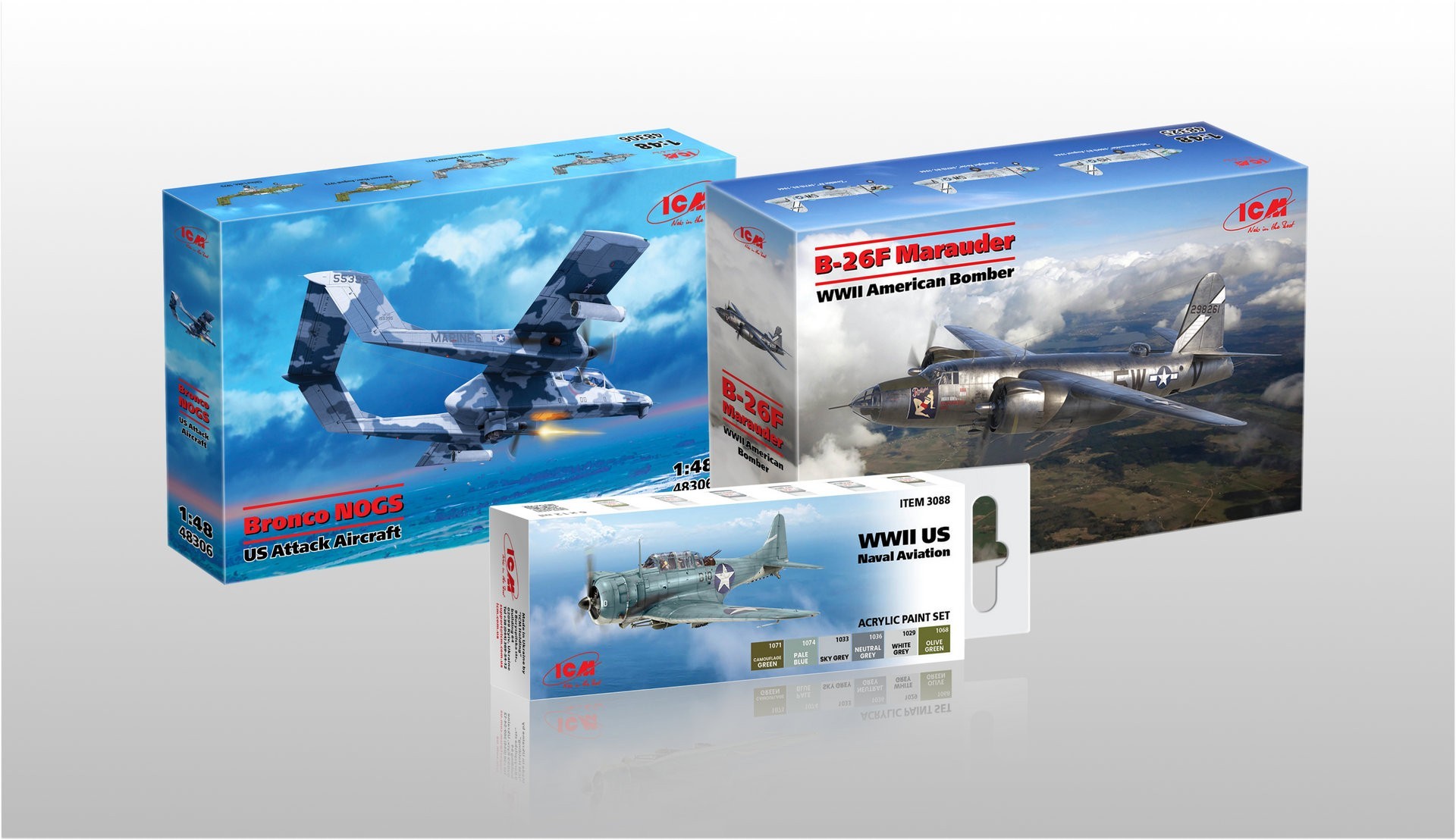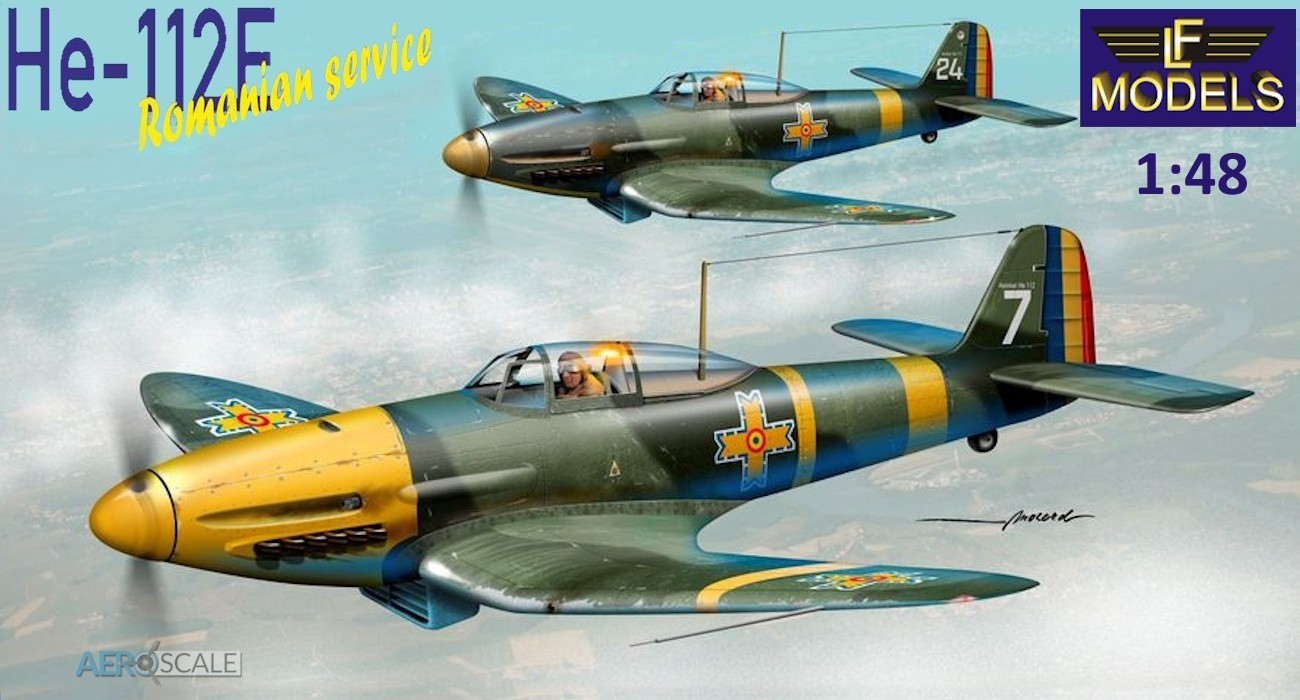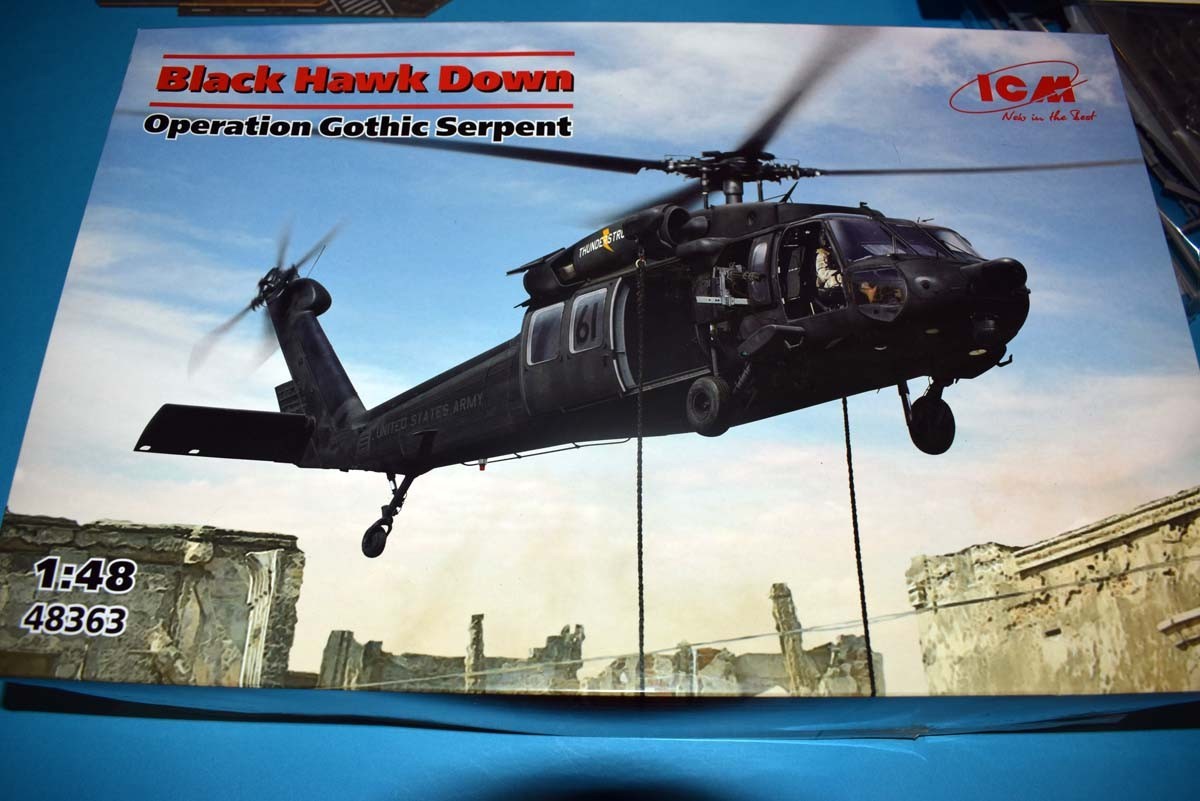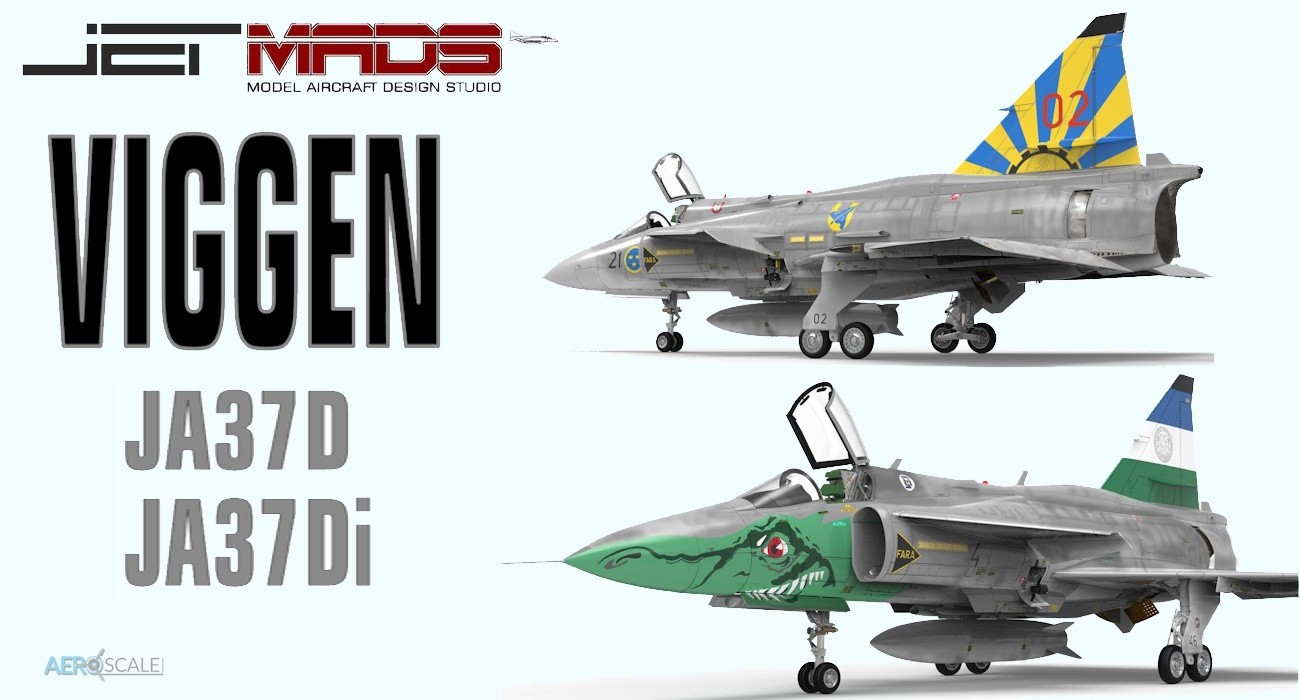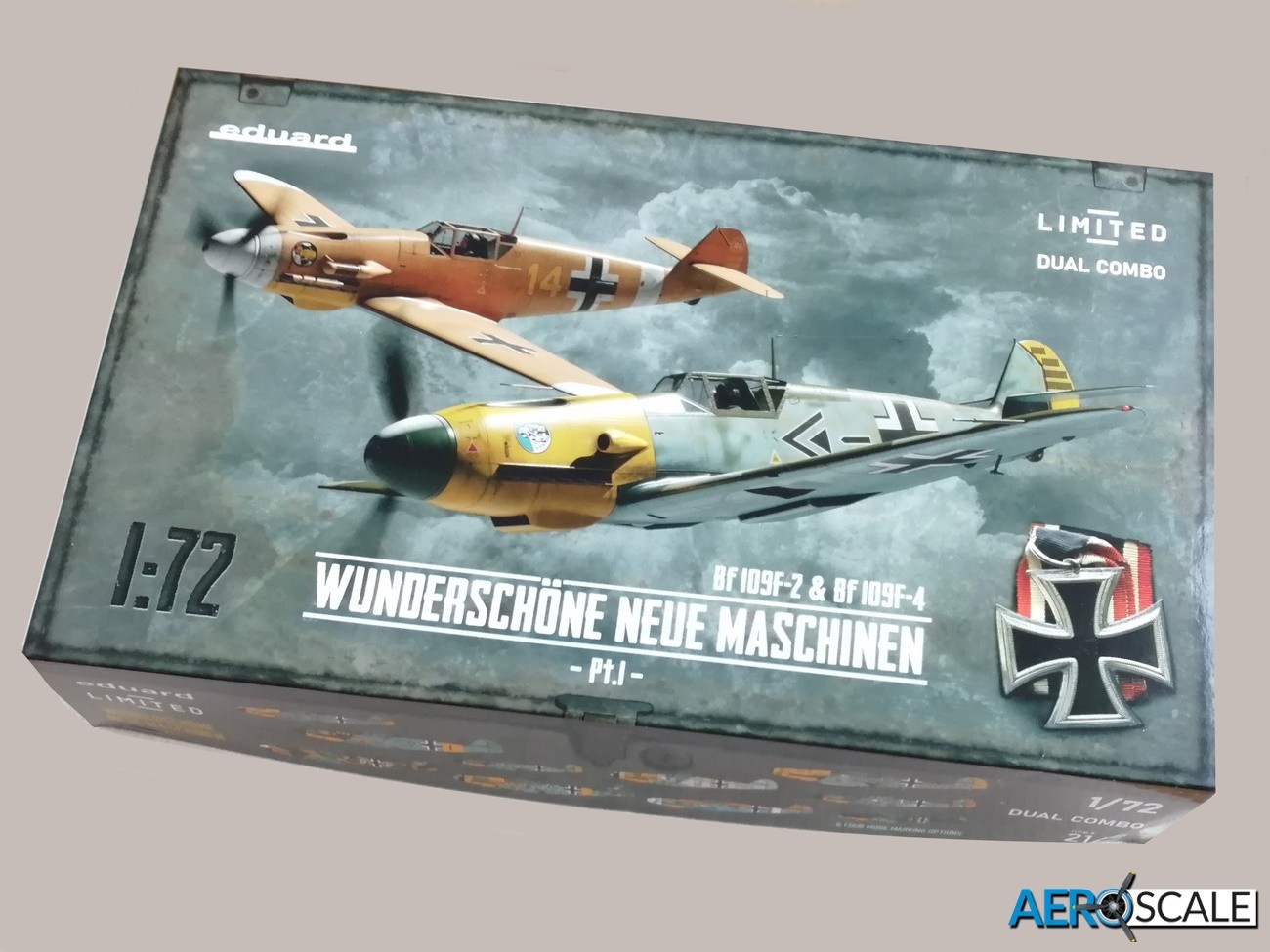
Background
The development of the Bf 109 F [Fredrick] was the desire to improve on its predecessor the Bf 109E. Work began in the autumn of 1938. On the outside the Bf-109 F appears to be more aerodynamic with pleasing curves, in comparison to its rather angular predecessor. The elliptical wingtips, large spinner, lack of tailplane support and the circular cross section compressor air intake were the significant differences externally. It was designed around the DB 601 E engine, with a designed output of 1350hp compared to 1100hp of the DB 601 A. The Bf 109 F-1 suffered quite a few problems once in service, though several structural failures in the tail were the most serious. It led to additional external bracing around the last bulkhead where the tail unit was attached. The DB 601N powered Bf 109F-2 had the bracing installed in the factory. The F-2 could be fitted with one SC250 500kg or four SC50 50kg bombs. These fighter bombers were designated F-2/B or F-2/Bo. The Bf 109F-4 was considered the best of the short series. The rear fuselage was redesigned so that the additional bracing of the F-1 and F-2 could be dispensed with. The F-4 airframe was developed in various ways. Like the F-2 it was employed as a fighter bomber [F-4/B]. The R-4/R-1s could be fitted with guns in underwing gondolas. There were photo reconnaissance variants F-4/R2/R3/R4/R8. Development and production of the Fredrick ended in May 1942 with the introduction of the Bf 109G-2.
From September 1941 the Bf109 F saw extensive service on the western front, English Channel, eastern front, Mediterranean and north Africa

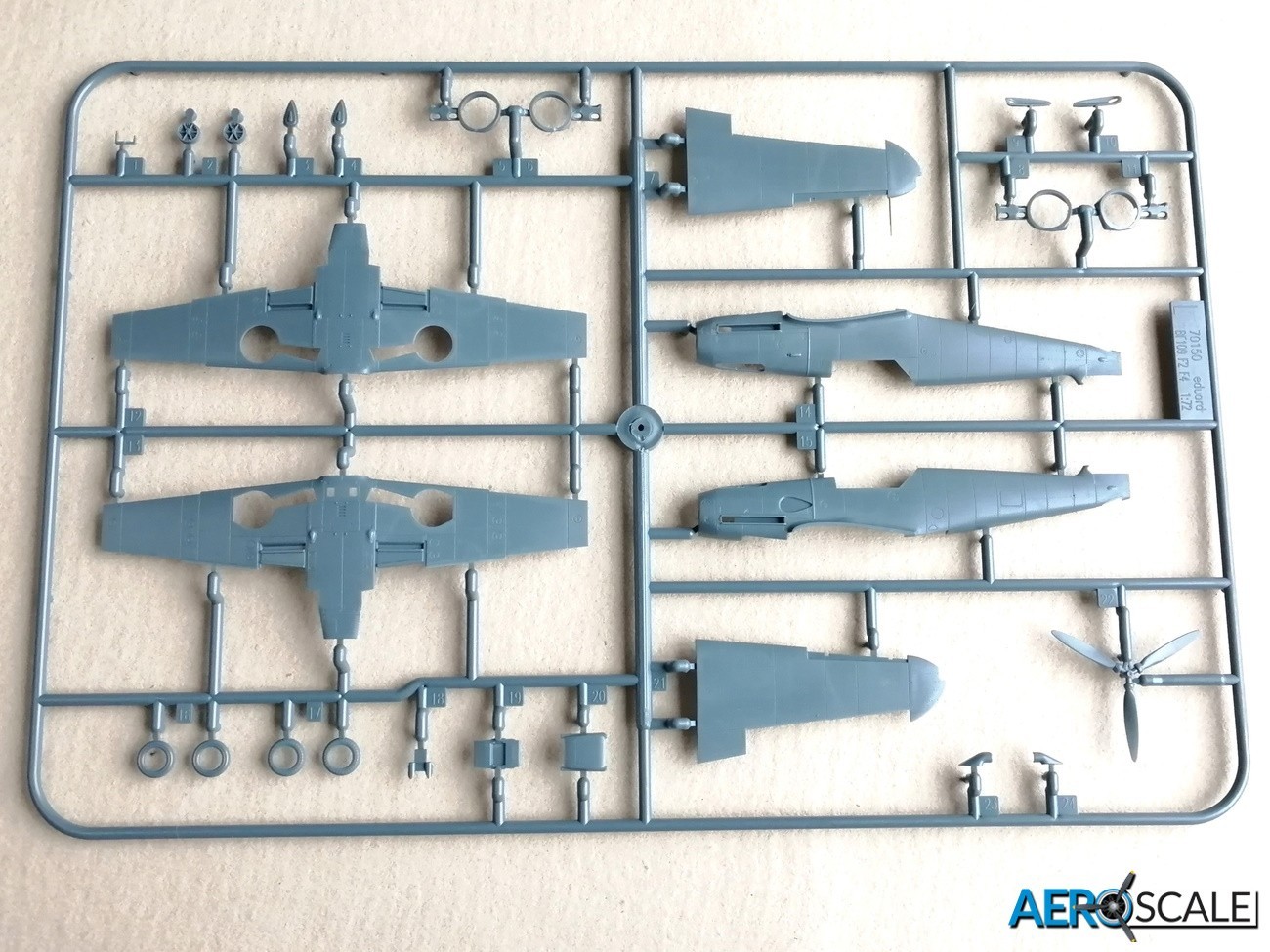

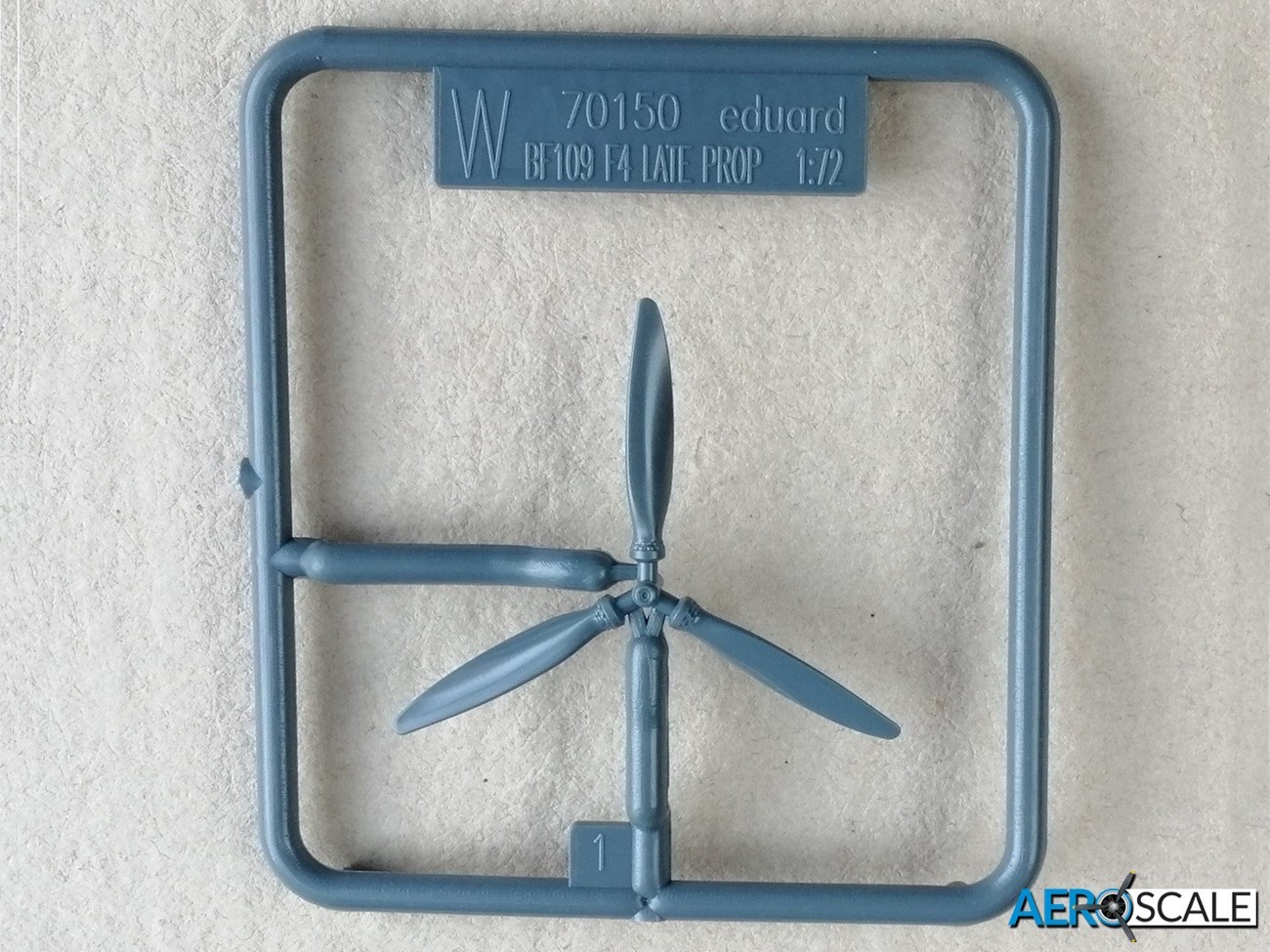
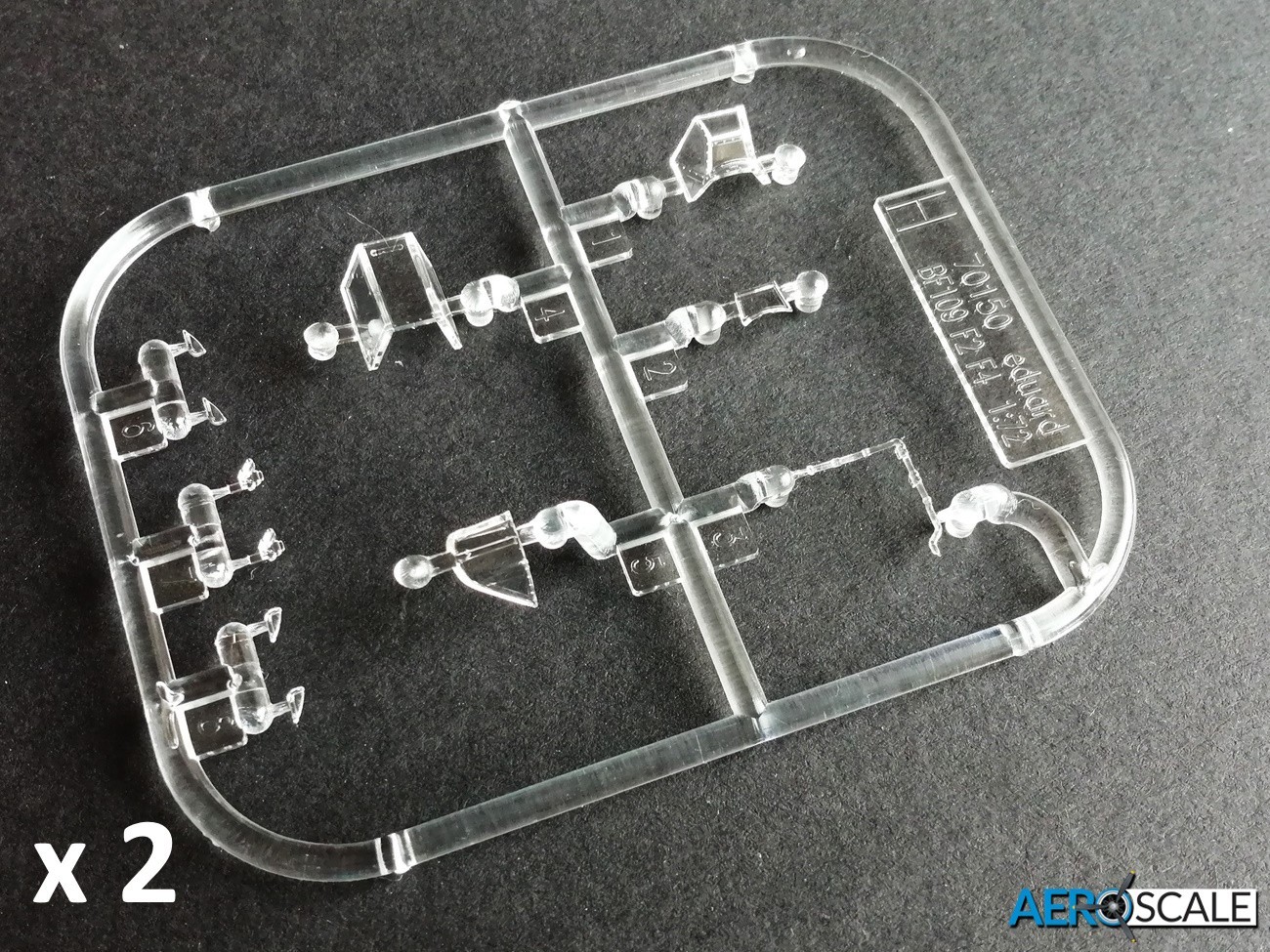
The Kit
Contents of this duo combo 1:72 scale release include:
- 5 x plastic sprues
- 2 x clear sprues
- 1 x pre-coloured photo etched fret
- 2 x bare metal photo etched fret
- 3 x decal sheets
- 1 x sheet of paint masks
- 1 x A4 format instruction manual
The recessed and raised detail is superb, particularly for this scale. The recessed rivets are particularly well executed. Interestingly what is not mentioned on the box lid is that one of the marking options [A] is for a single Bf 109F-1. Eduard has produced separate sprues layouts for the F-2 and the F-4. The F-4 sprue features two different lower wings as the wheel wells were either rounded or trapezoidal in shape.
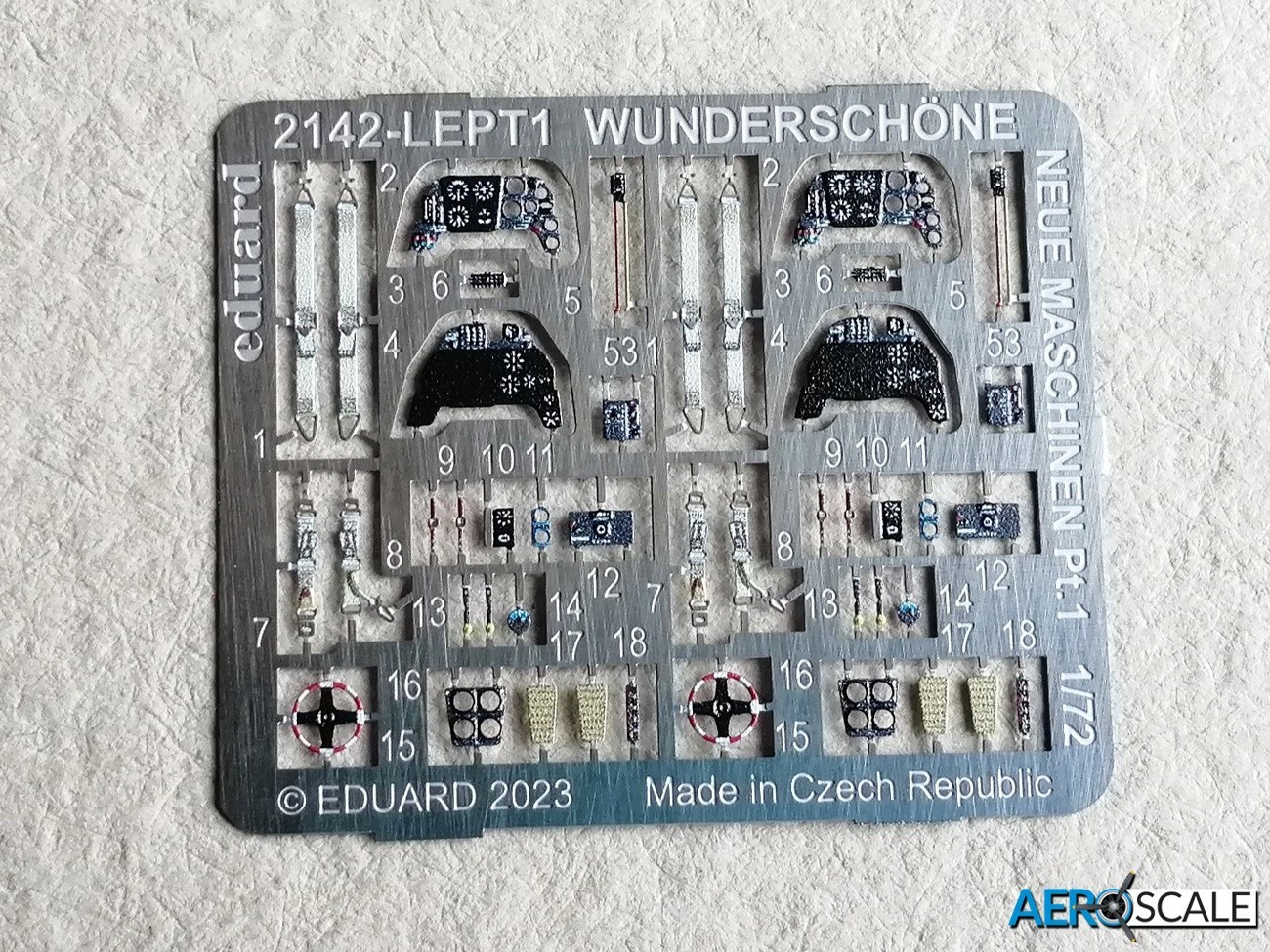

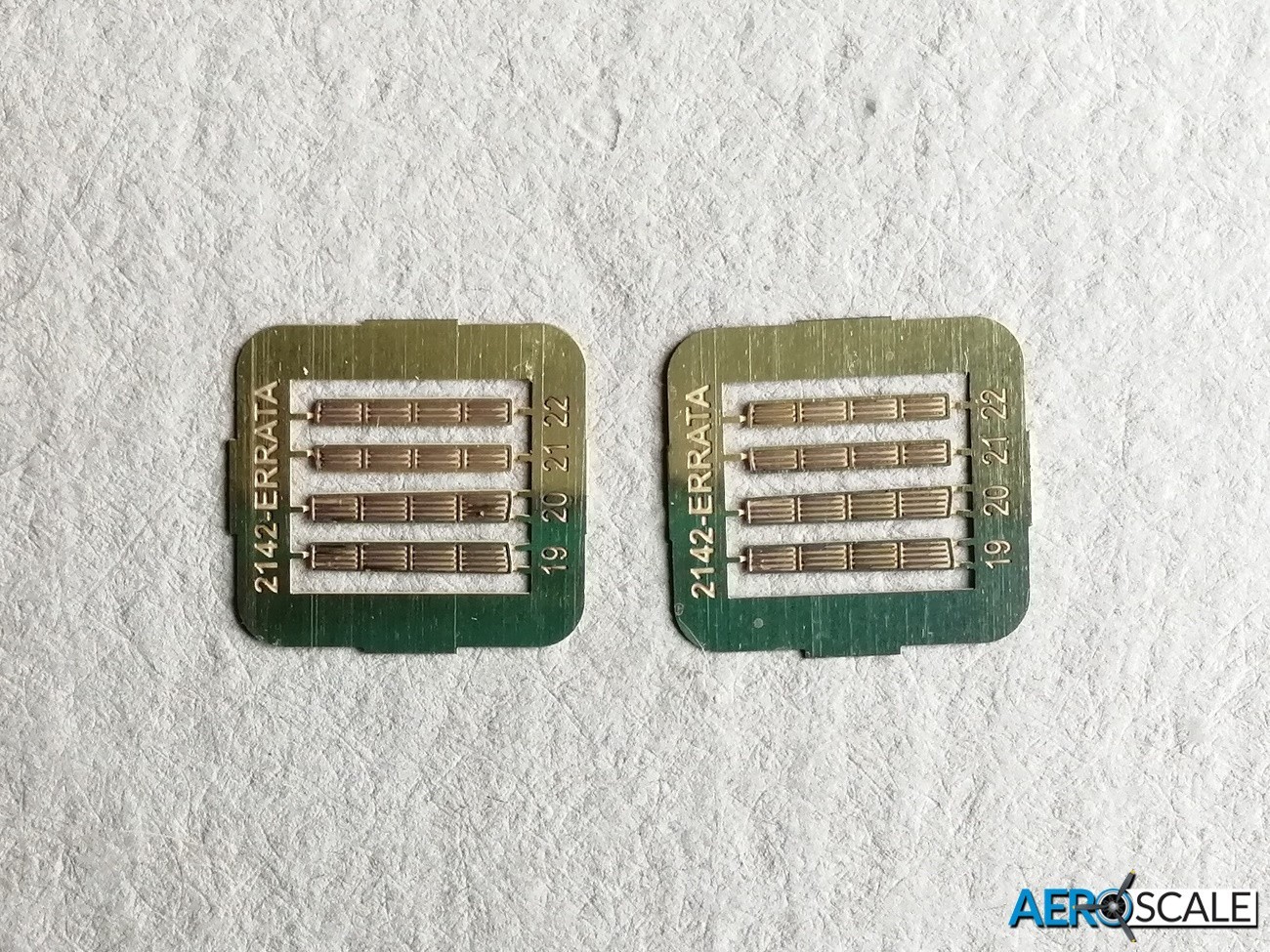
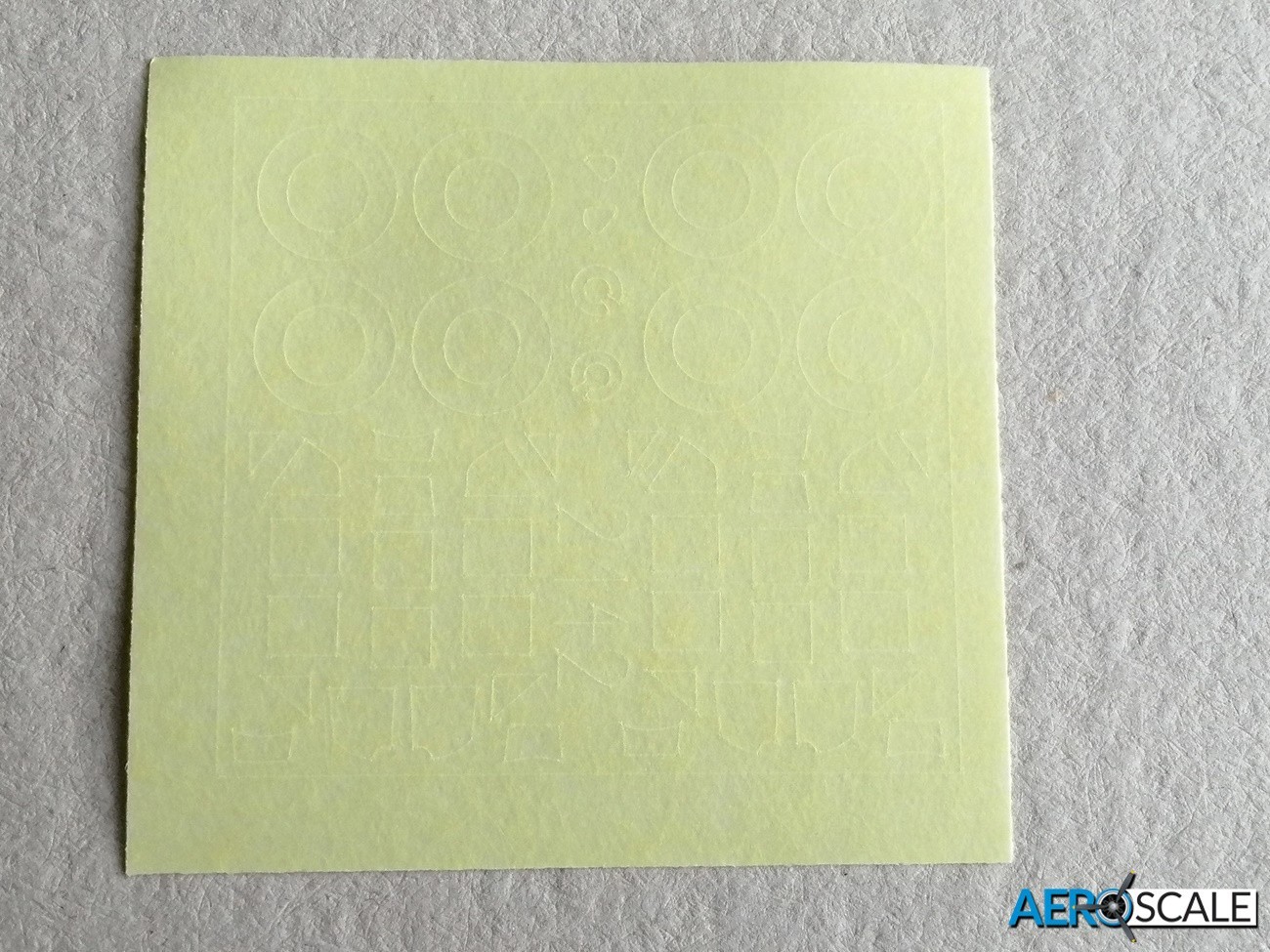
There are around fourteen plastic, 25 pre-painted photo etched [PE] parts and seven decals making up the cockpit. The decals are alternate parts to some of the PE bits. The main component of the cockpit is the combined floor and rear wall. This part also includes part of the undercarriage [U/C] bay. Attached to the floor are a set of rudder pedals, though Eduard has supplied PE rudder pedals with straps included on the bare PE fret. The only difference I can detect from the F-2 and F-4 cockpits, is that the F-2 has an extra panel attached to the bottom of the instrument panel [IP]. The detail for the IP comes in the form of pre-coloured PE, decals or you can dry brush to highlight the beautifully moulded IP. The F-2 has a choice of seat pans. There are raised instruments moulded onto the side wall. Additionally, Eduard supply extra parts to add detail to the sidewall and includes a clear plastic part representing the fuel line. A check on the outside of the fuselage corresponding to the position of the internal raised detail reveals no obvious shrinkage. For the F-2 there are two styles of seat pan. Eduard mention that one of the seat pans was rarely used and leave it up to the modeler whether to fit it. There are pre-coloured PE seat harnesses to fit. Once complete the cockpit fits into the underside of the constructed fuselage
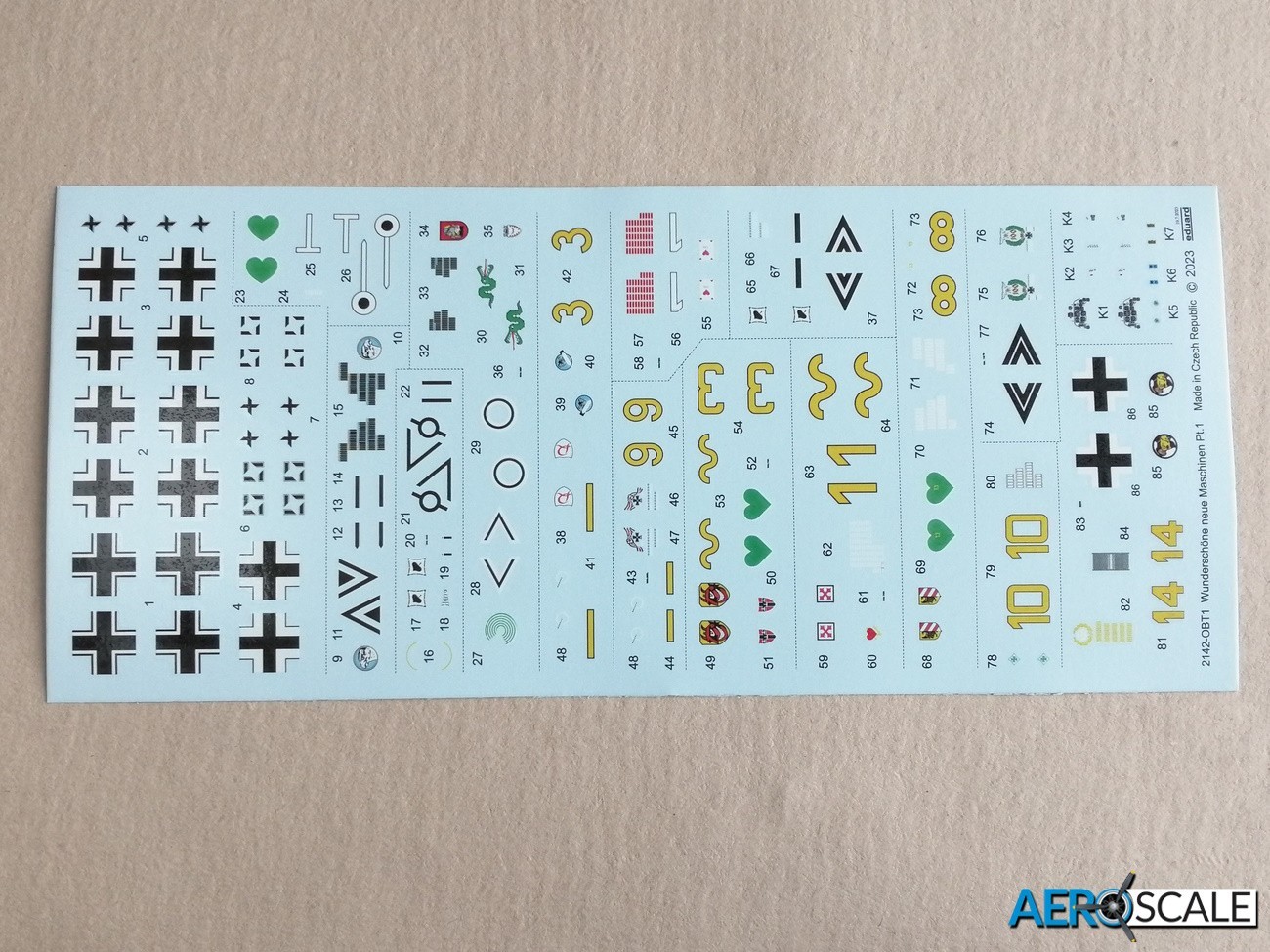
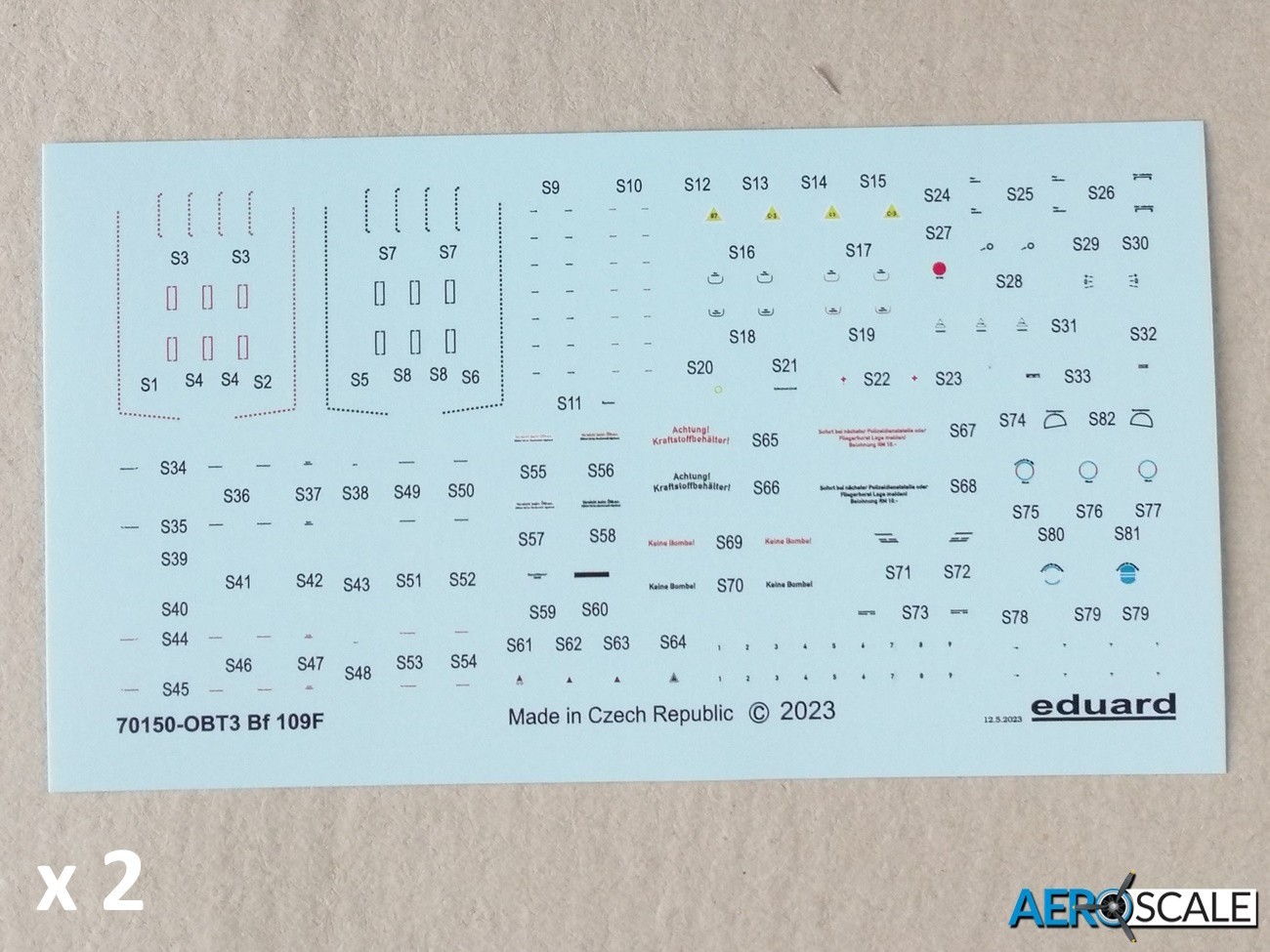
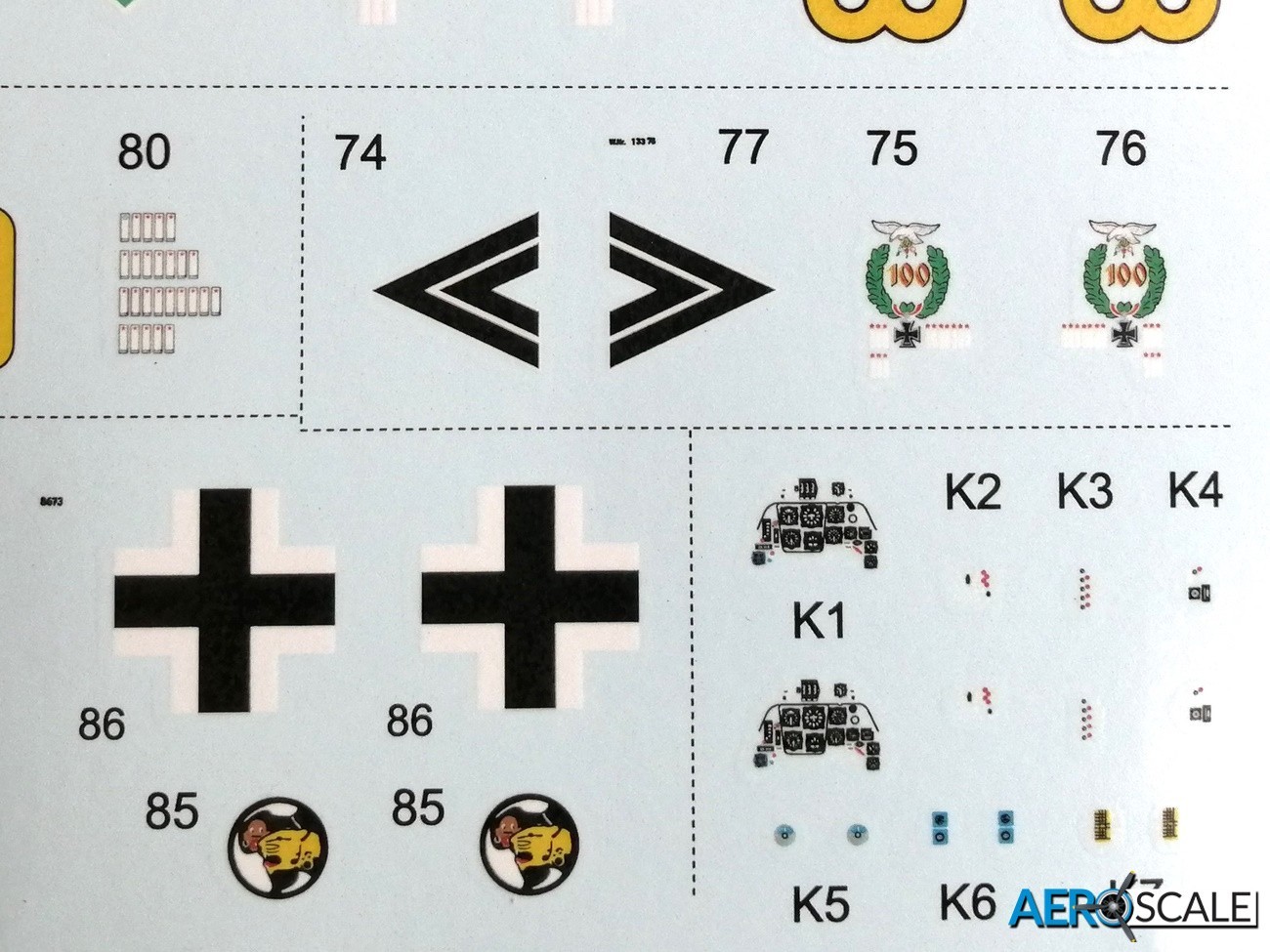
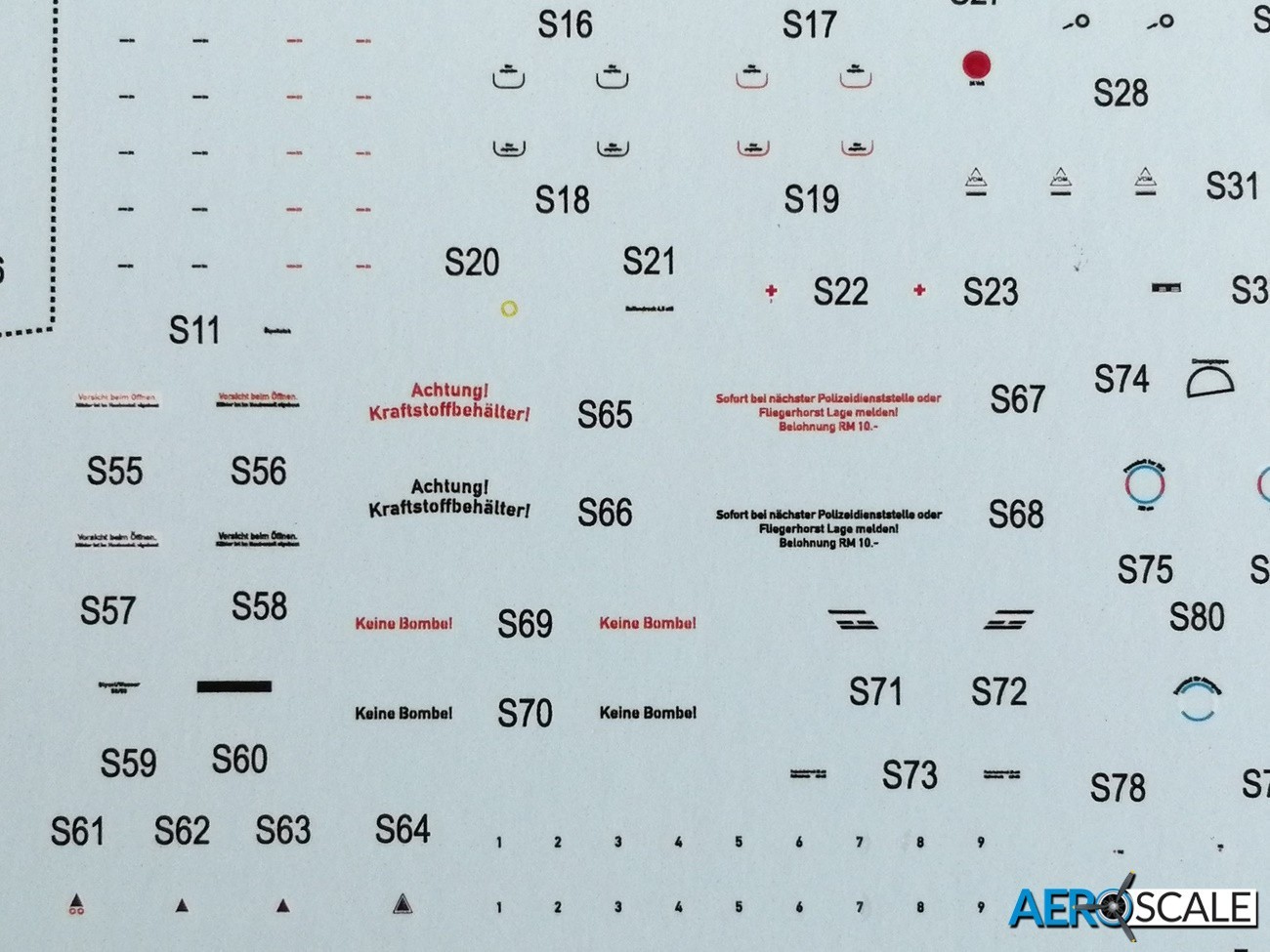
The three-part canopy, well four if you include the separate armoured windscreen, has additional plastic and PE parts to fit. So, some care will be need not to mar the clarity of the parts. Eduard has included a PE canopy restrainer if you want to display the side opening canopy.

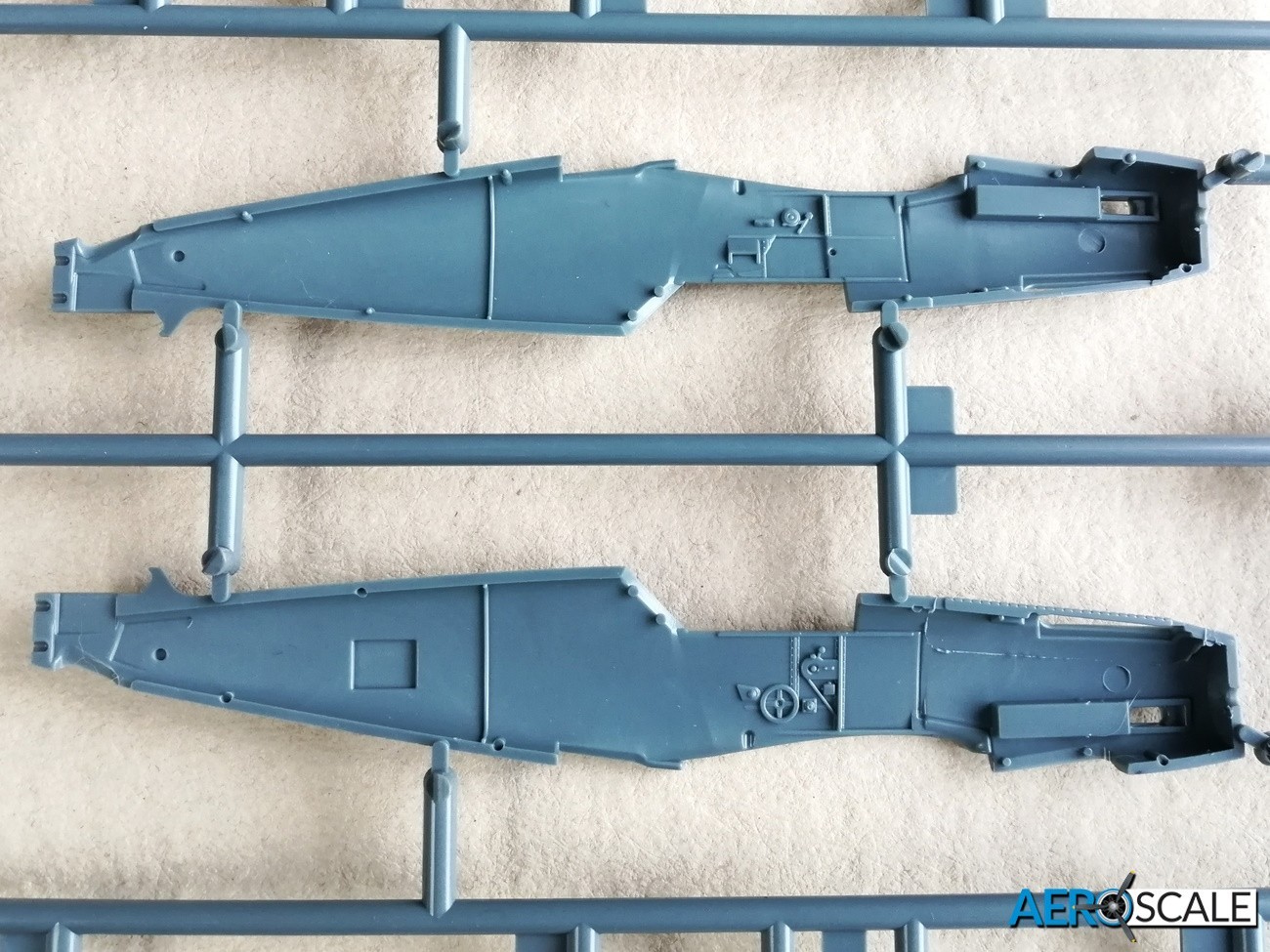
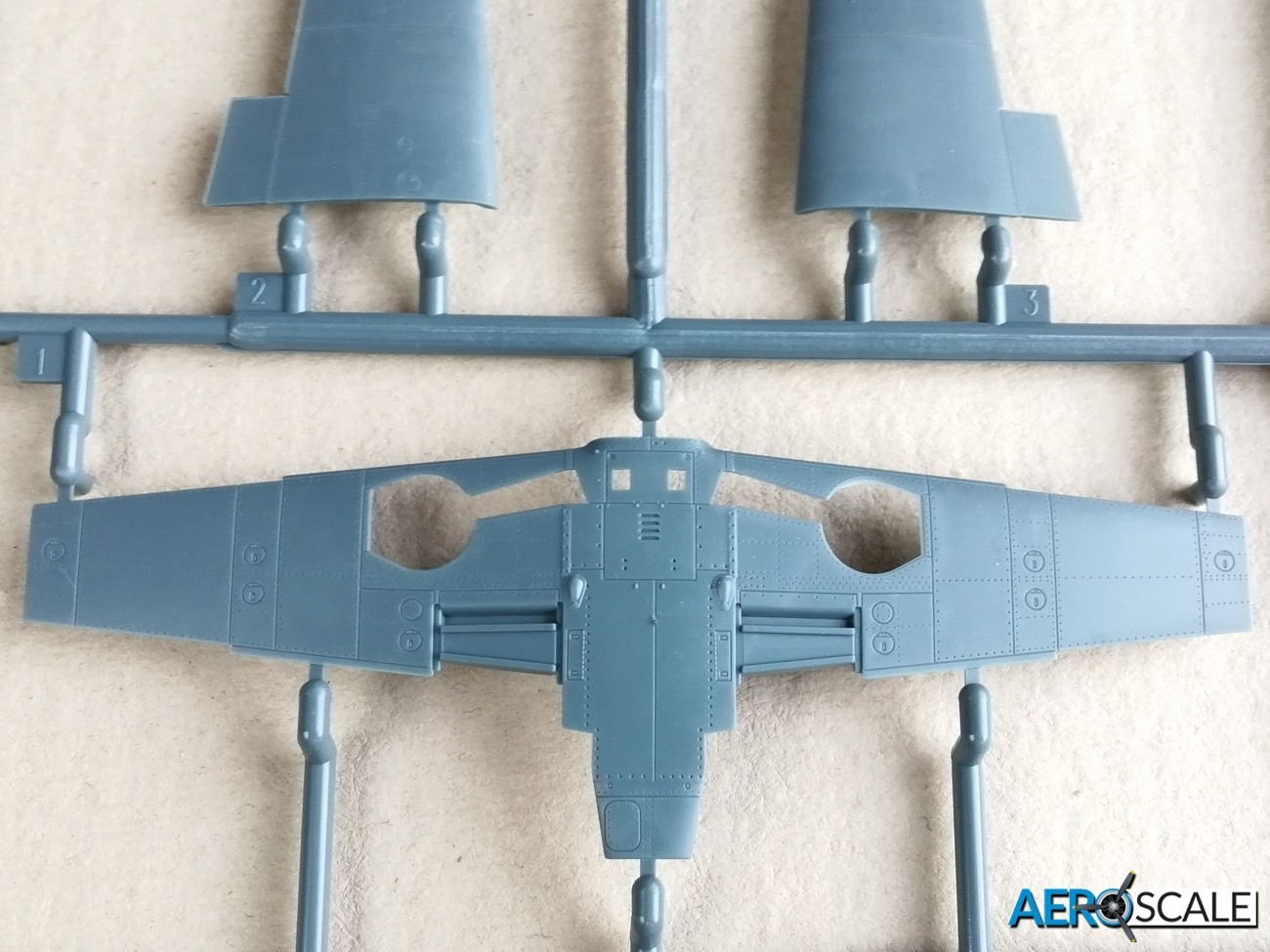


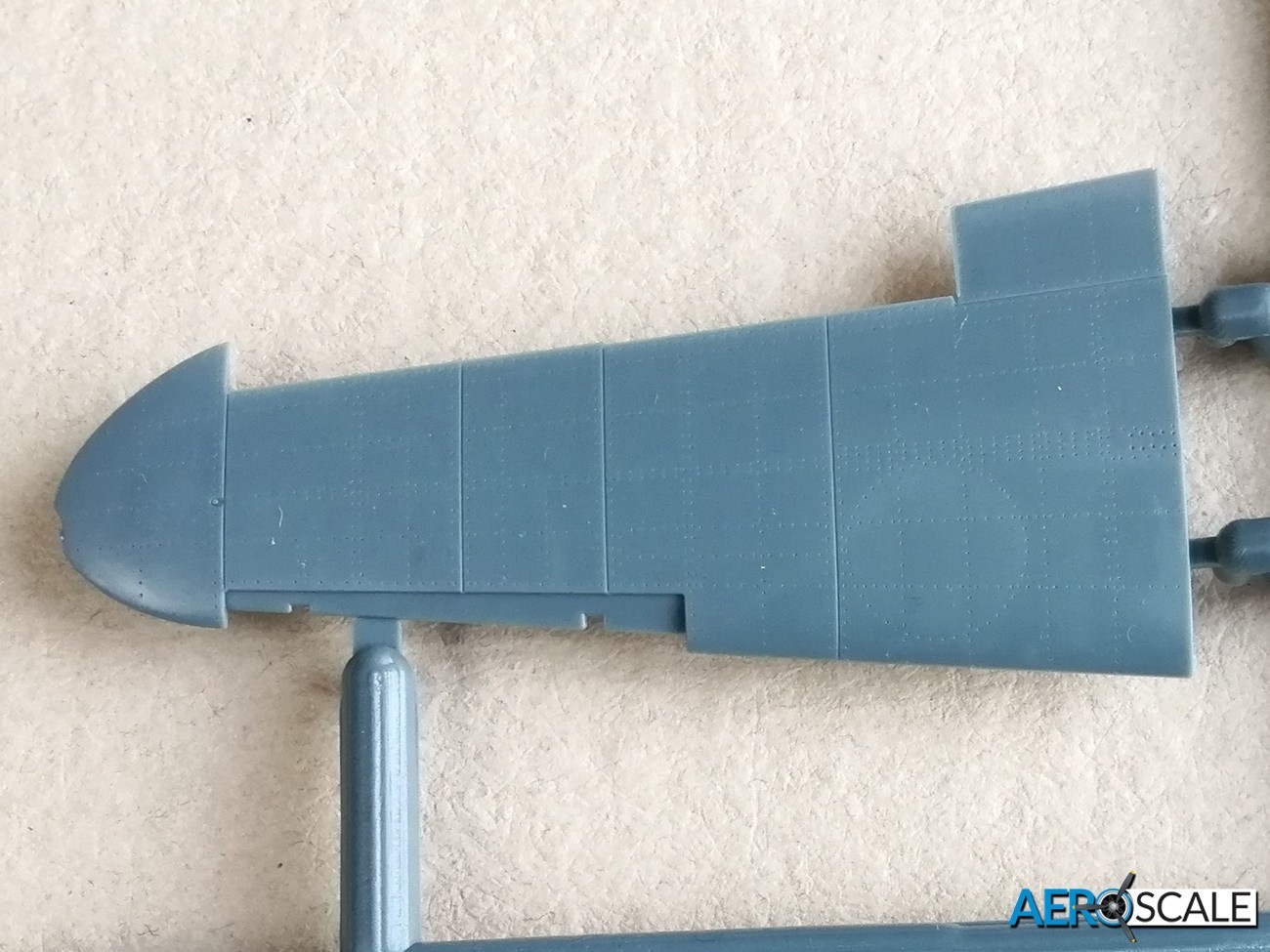
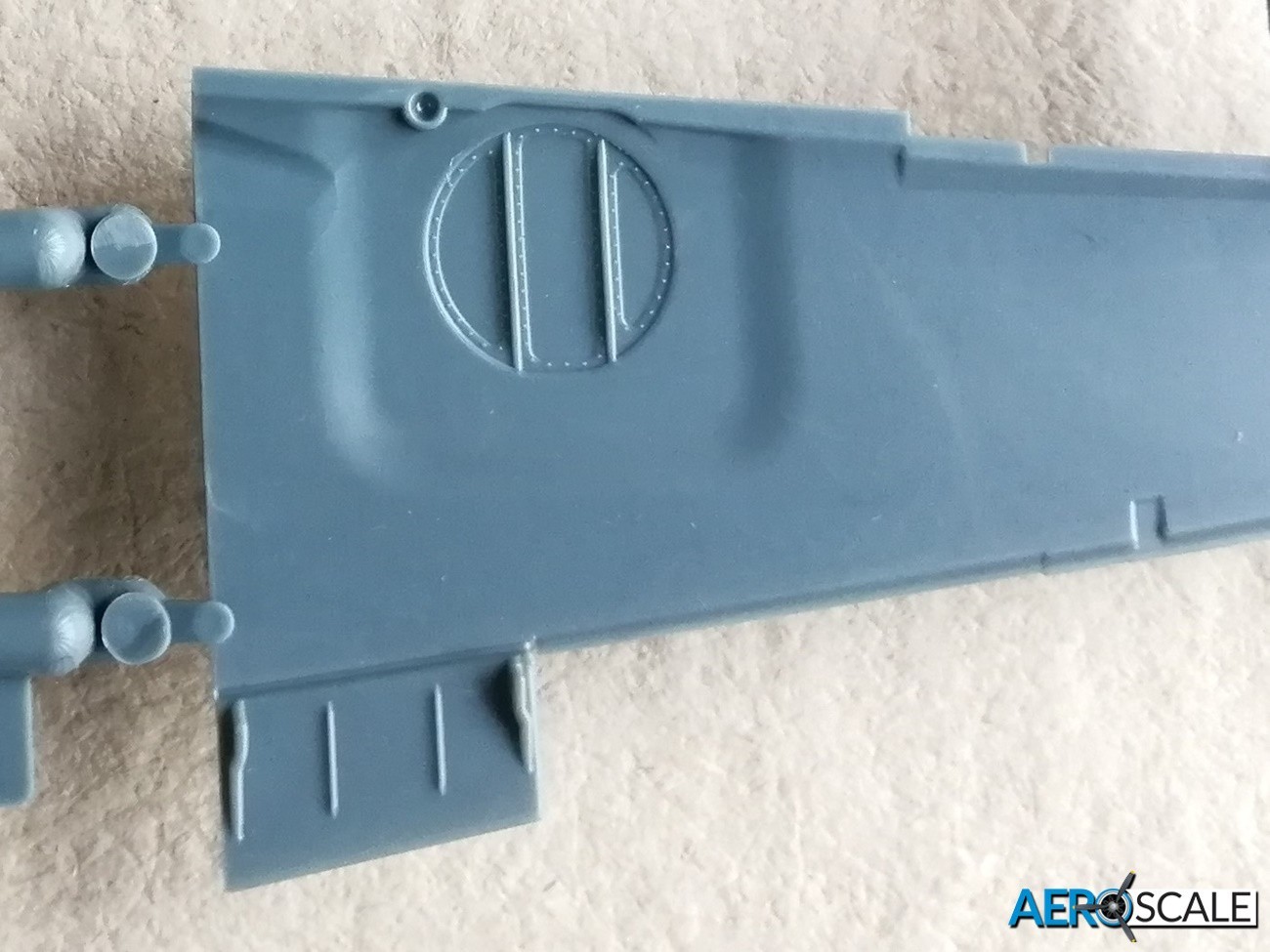

The fuselage is split traditionally into left and right halves. The vertical tail is separate and simply slots into its location. There is a generous tab attached so it should prove to be a strong joint. The rudder is one piece and has a fine trailing edge. The access hatch for the radio equipment has thinner plastic, making it easier to remove if you want to open it up for the radio equipment supplied separately. The fairings for the two upper fuselage MG 17’s are separate into which fit the one piece staggered barrels. The separate exhausts look fine for this scale. One set of exhaust feature a moulded-on flame guard. For a better look there are PE flame guards you can fit on the exhausts instead. There are two types of prop with subtle differences. The prop unit is made up from three parts. Some of the patterns painted on the spinner are complex, and Eduard has supplied decals for options B and D. Eduard has supplied two styles of low-profile oil cooler fairing under the nose. Both come with PE radiator faces. There are two types of circular cross section compressor air intakes each made up from three parts, and there are tropical filters included for the two off the marking options. Well, it would not be an Eduard kit if they did not provide options even for the filter. Eduard supplies PE parts or a decal to replicate the perforated look of the filter. Eduard has supplied a couple of engine start handles. There is a PE strengthening plate to add to the outside of the fuselage above the wing root for the Bf 109F-1 [option A]. The sprue K featuring the fuselage for the F-1/2 has four strengthening plates moulded onto the tail section. The fuselage on sprue L with the fuselage of the F-2/4 does not have the moulded re-enforcing. Marking options ‘H,I & N’ require the plates and these are supplied as PE parts.
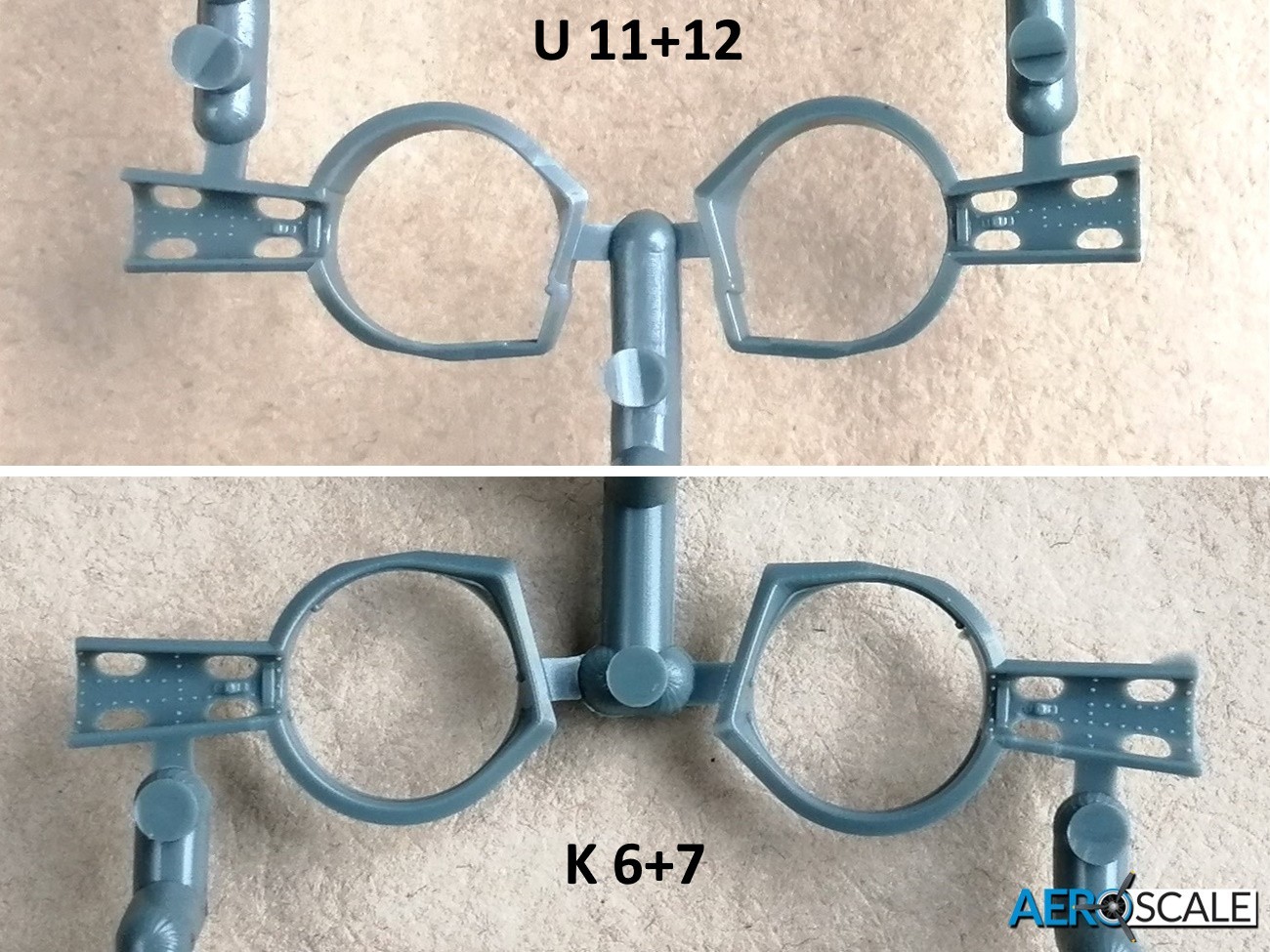


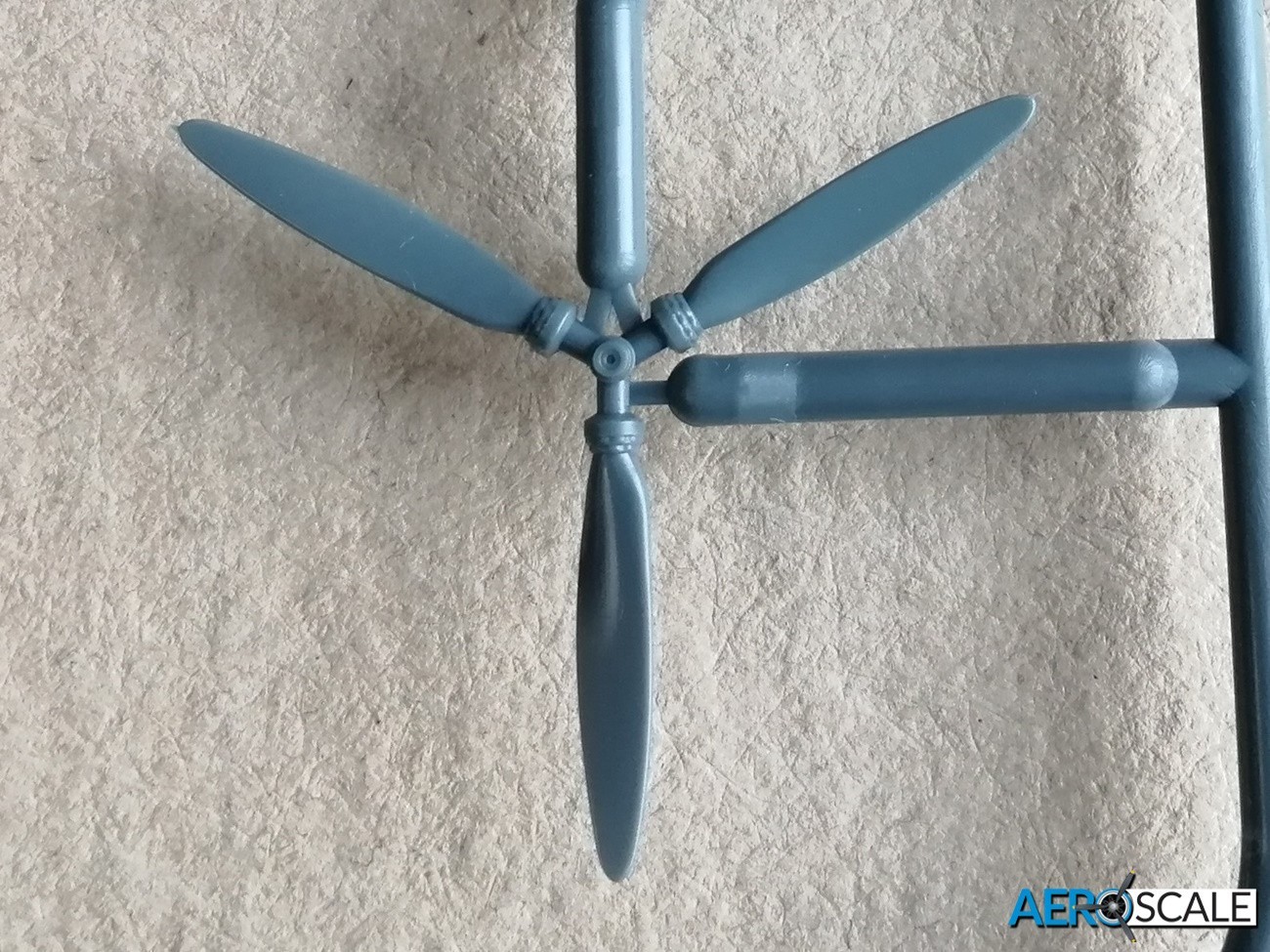
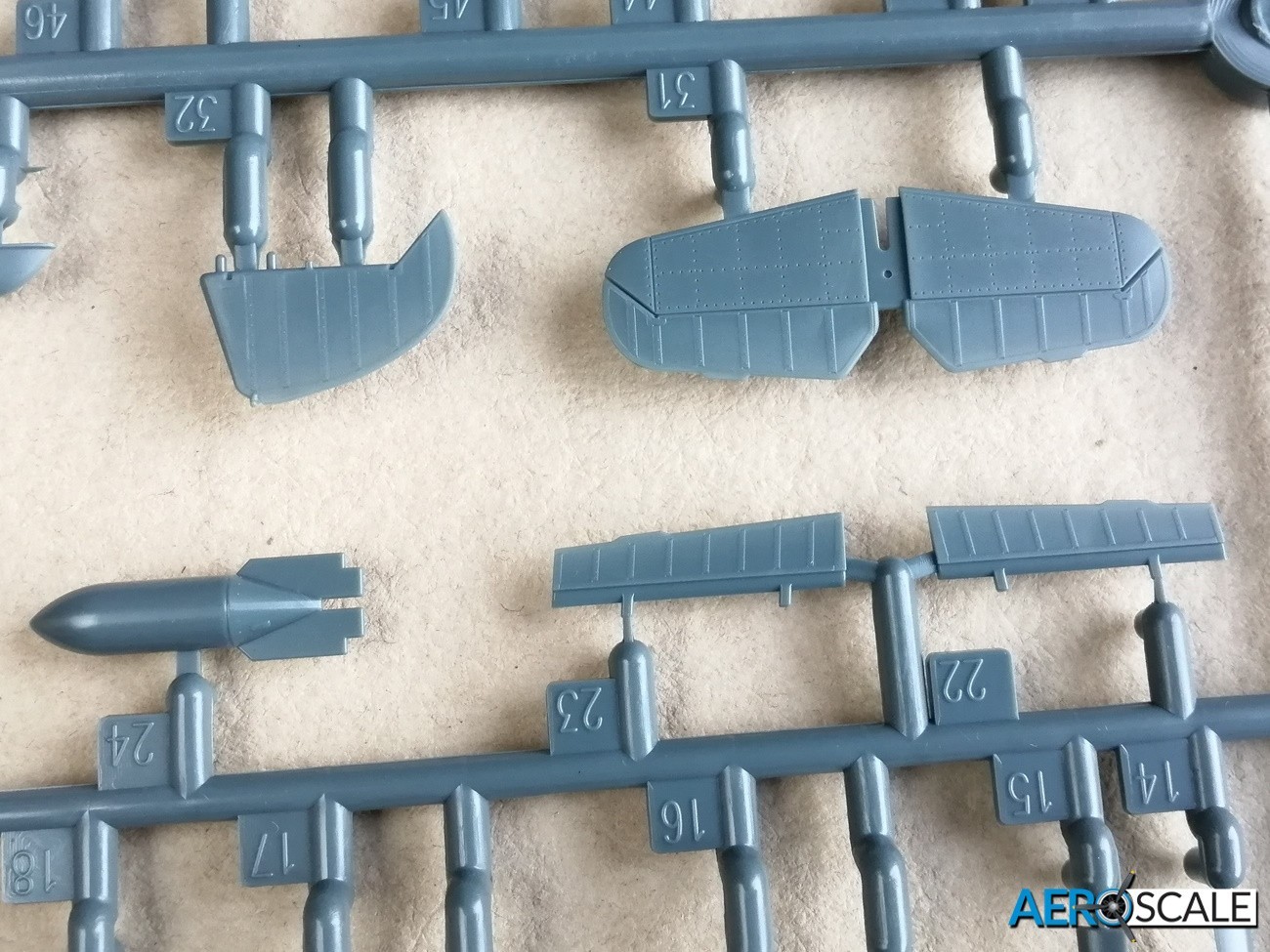
The wings are three pieces, with the lower wing one piece. There are numerous partial holes acting as guides for drilling out for underwing guns and under fuselage fuel tanks and bombs. With this edition only option ‘E & G’ is fitted with a SC 250 bomb and ETC bomb rack. The elevators, flaps and leading-edge slats are separate. The flaps are set in a dropped position. The fairings for the underwing glycol coolers are separate. They include the flap, though the instructions suggest that the flaps can be positioned to your choice with some gentle coaxing. There are four PE parts representing the radiator faces. Just note there is an errata set of radiator faces, presumably these replace the ones on the larger bare P/E fret. There are a couple of panels that need to be lightly shaped that fit on the lower wing. The kit features faired and non-faired navigation lights on the wing tips. There are paint masks for the clear parts for the clear parts representing the fairing.
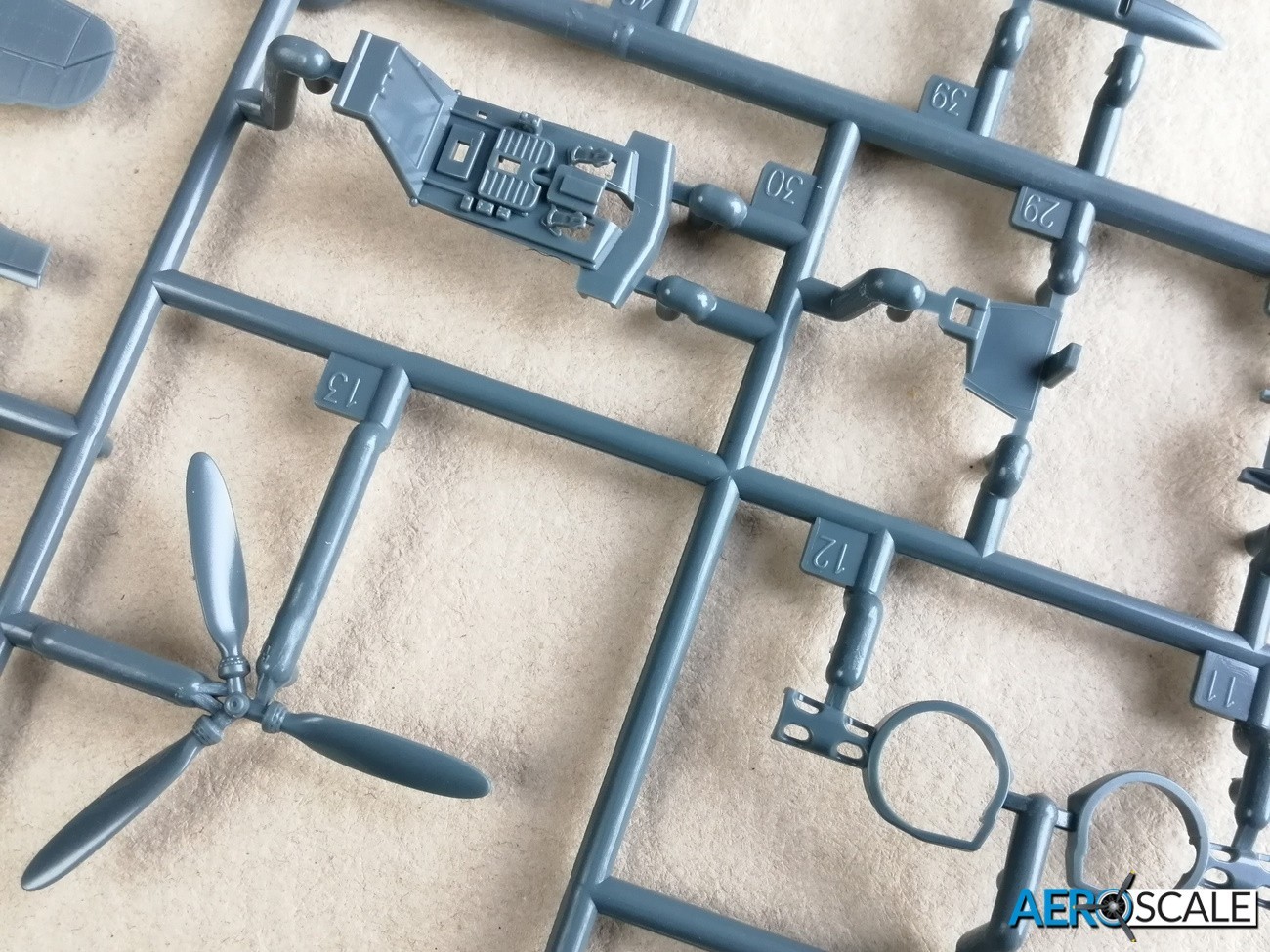
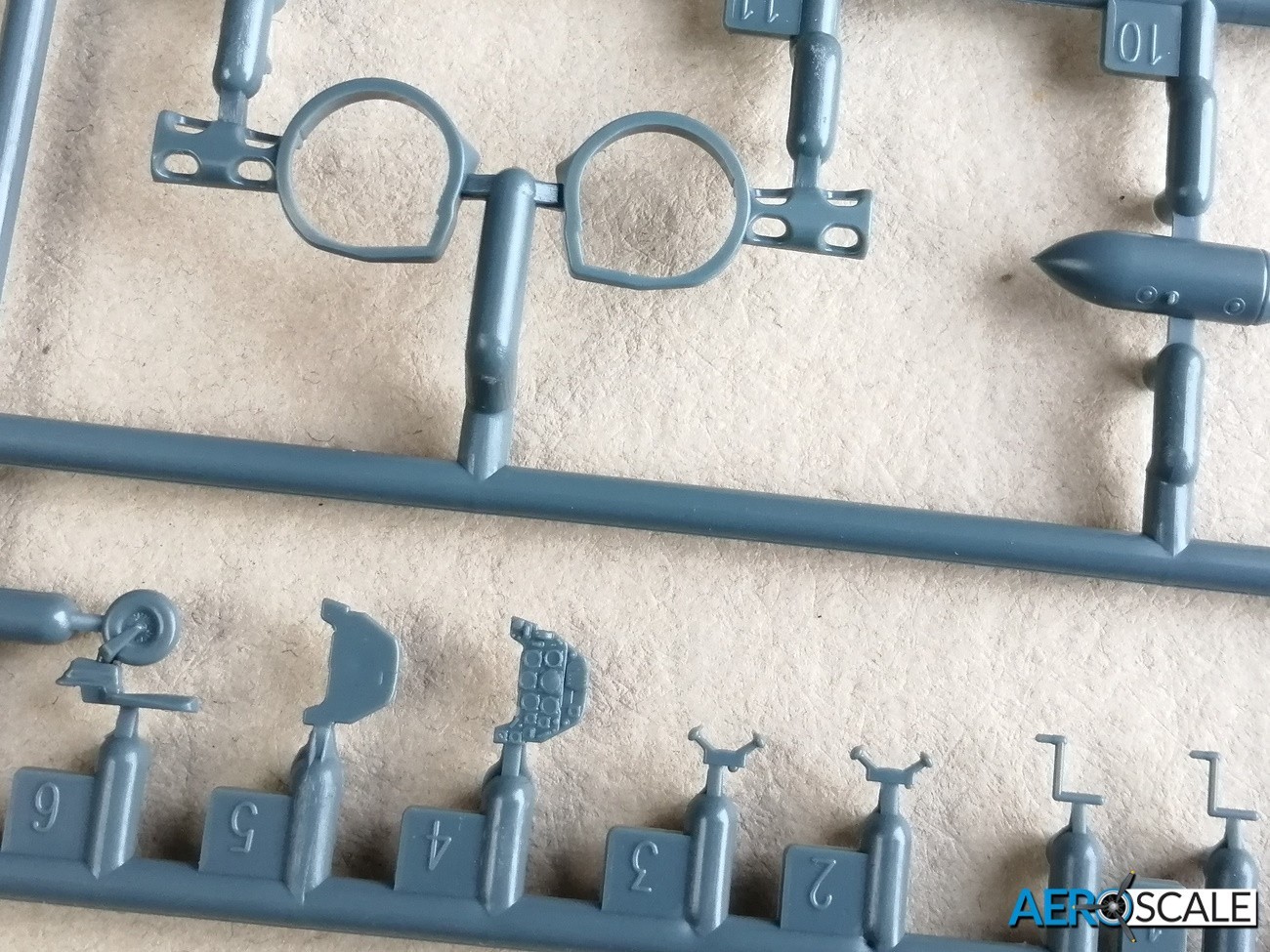
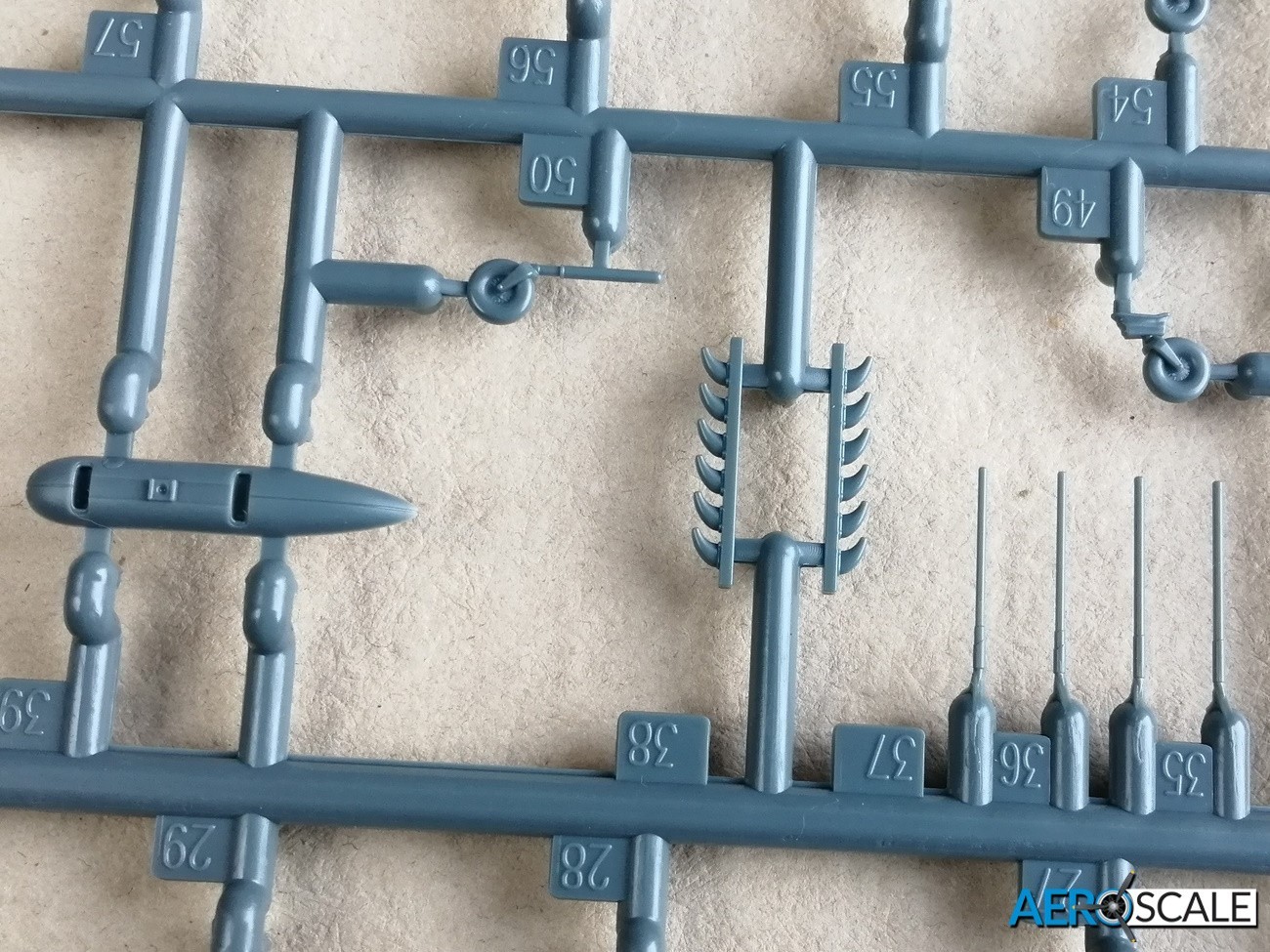

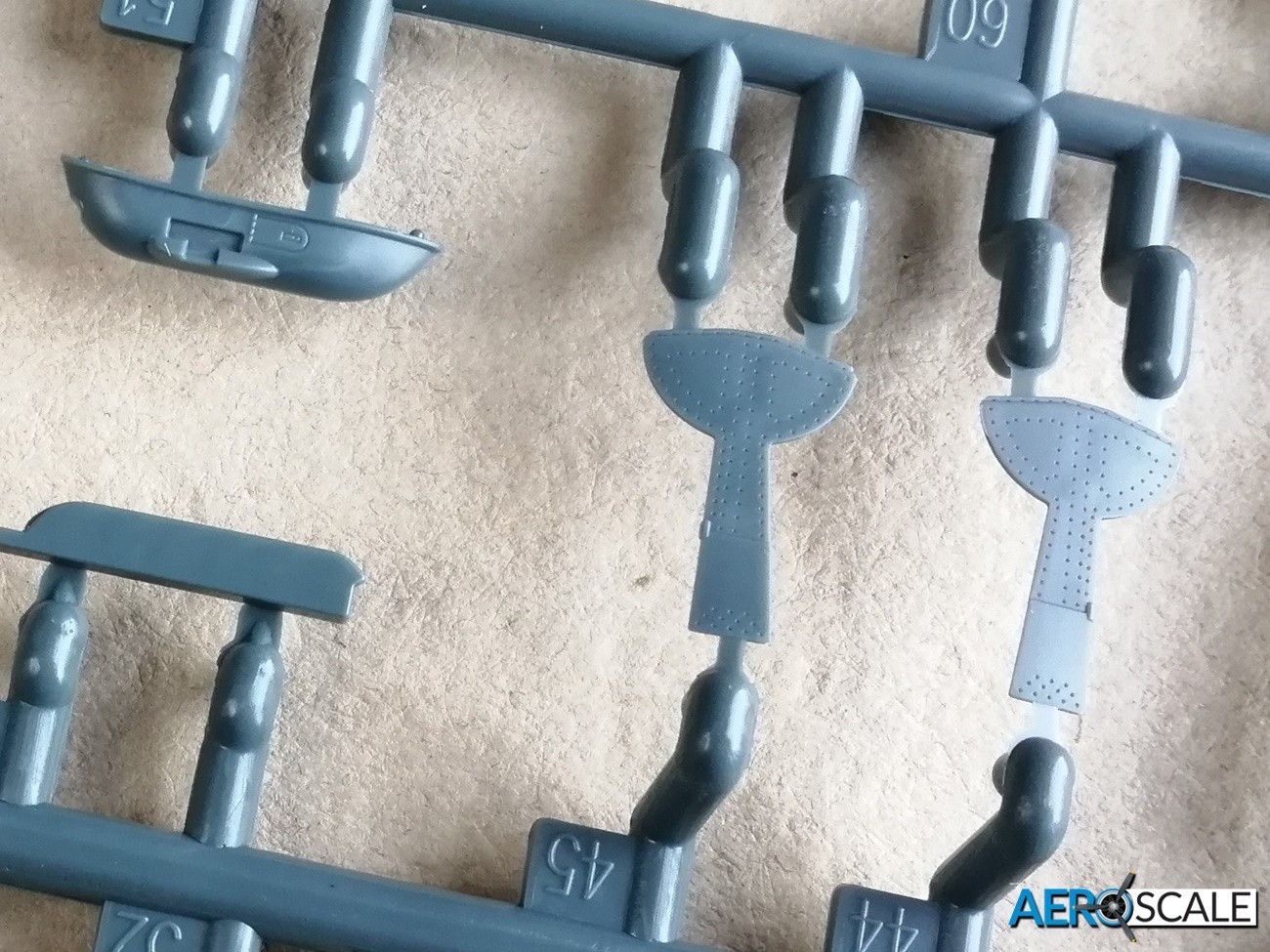
The shape of the wheel well is interesting feature of the Fredrick. Most F-1/2 and some F-4’s had what Eduard describe as a trapezoidal shaped wheel wells. Most F-4’s and some F-2’s had circular shaped wheel wells. To make the build even more interesting option ‘K’ had the trapezoid wheel well on the left wing and the circular on the right wing, Just, be careful here with the instruction with option ‘K’ as Eduard misidentify part L10 fitting in the left wing. Its possibly part L11. A little surgery is required to fit L11 into place, a case of fitting a trapezoid shape into a round hole. Eduard show which bit of plastic to remove in the instructions.
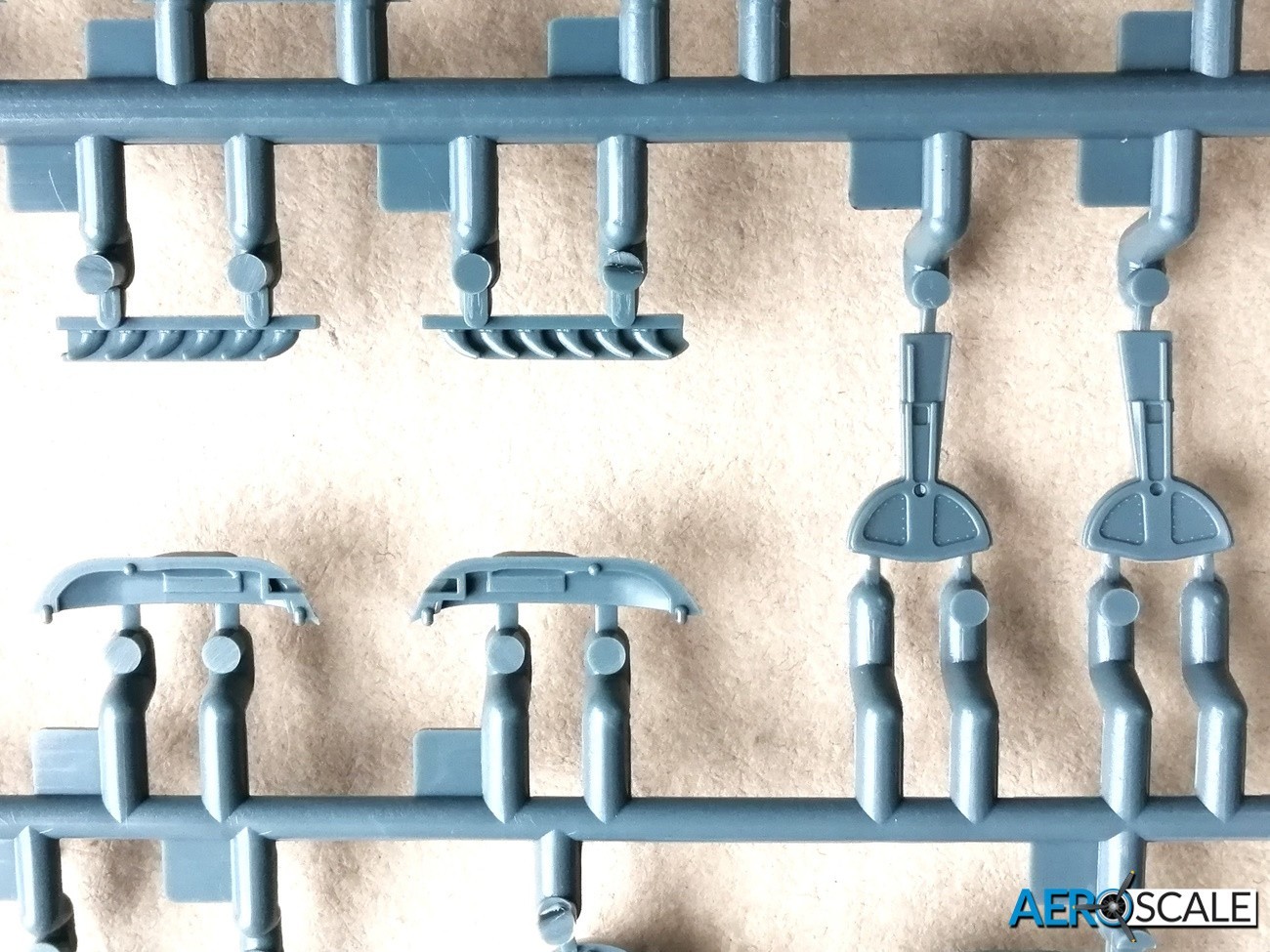
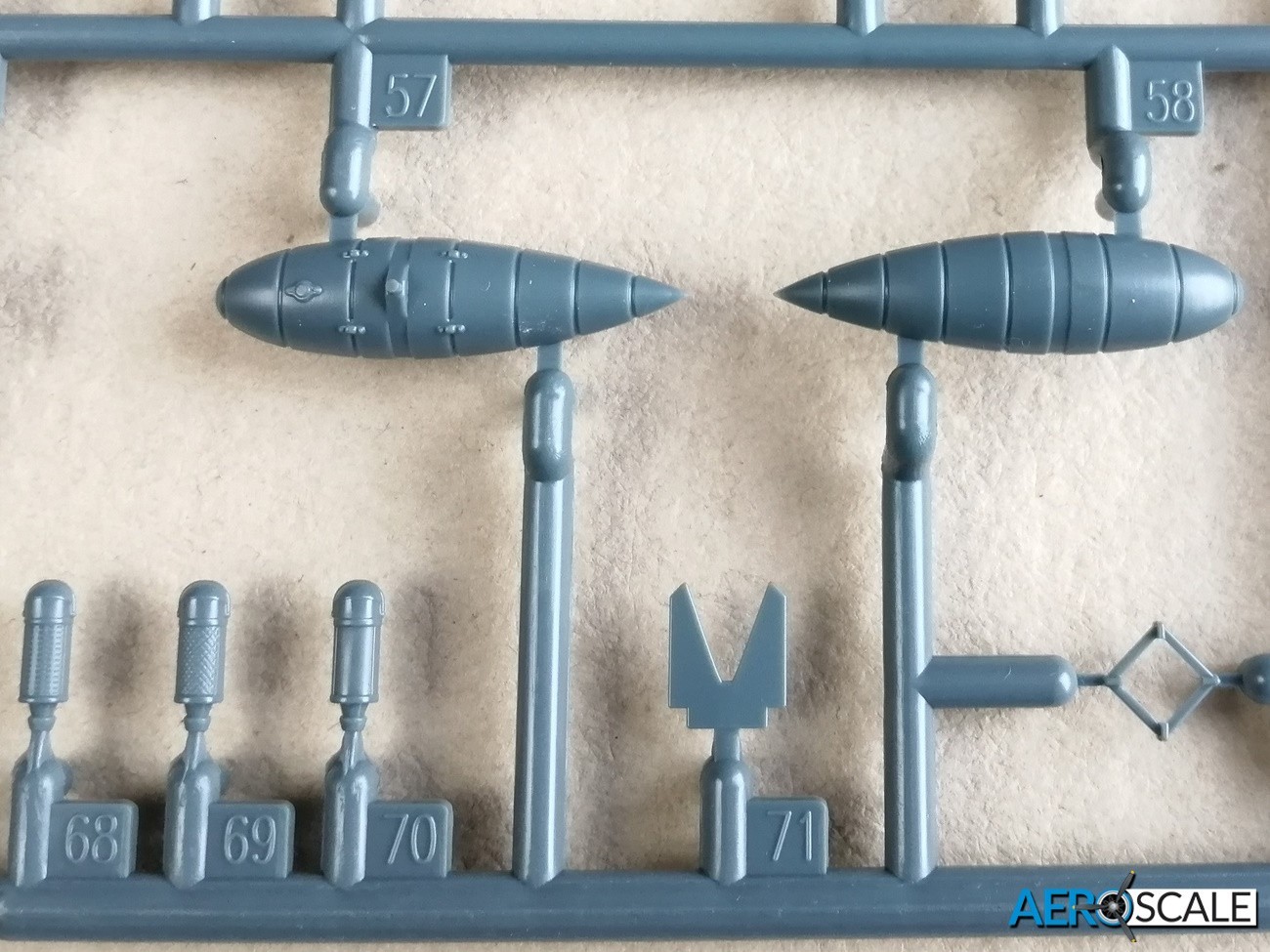
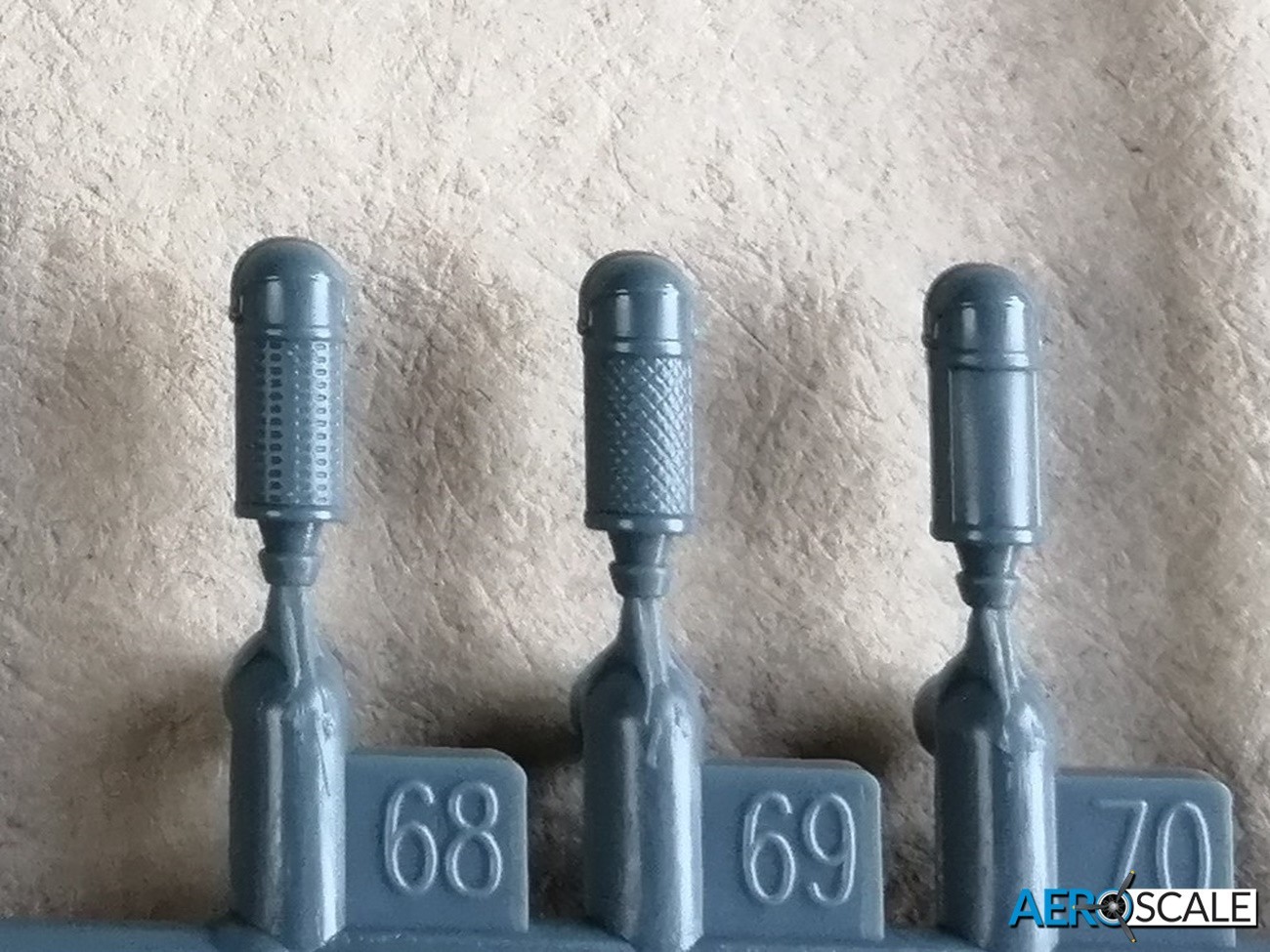
The horizontal tailplane is one piece. The elevators are moulded in the neutral position. The unit simply slides into the rear of the fuselage.
The undercarriage legs have PE hydraulic line to attach. The attachment for the legs into the fuselage looks very positive and should provide the correct angle for the legs. The tyres in three different styles are one piece. Each side of one wheel has separate hubs, which are crisply detailed.
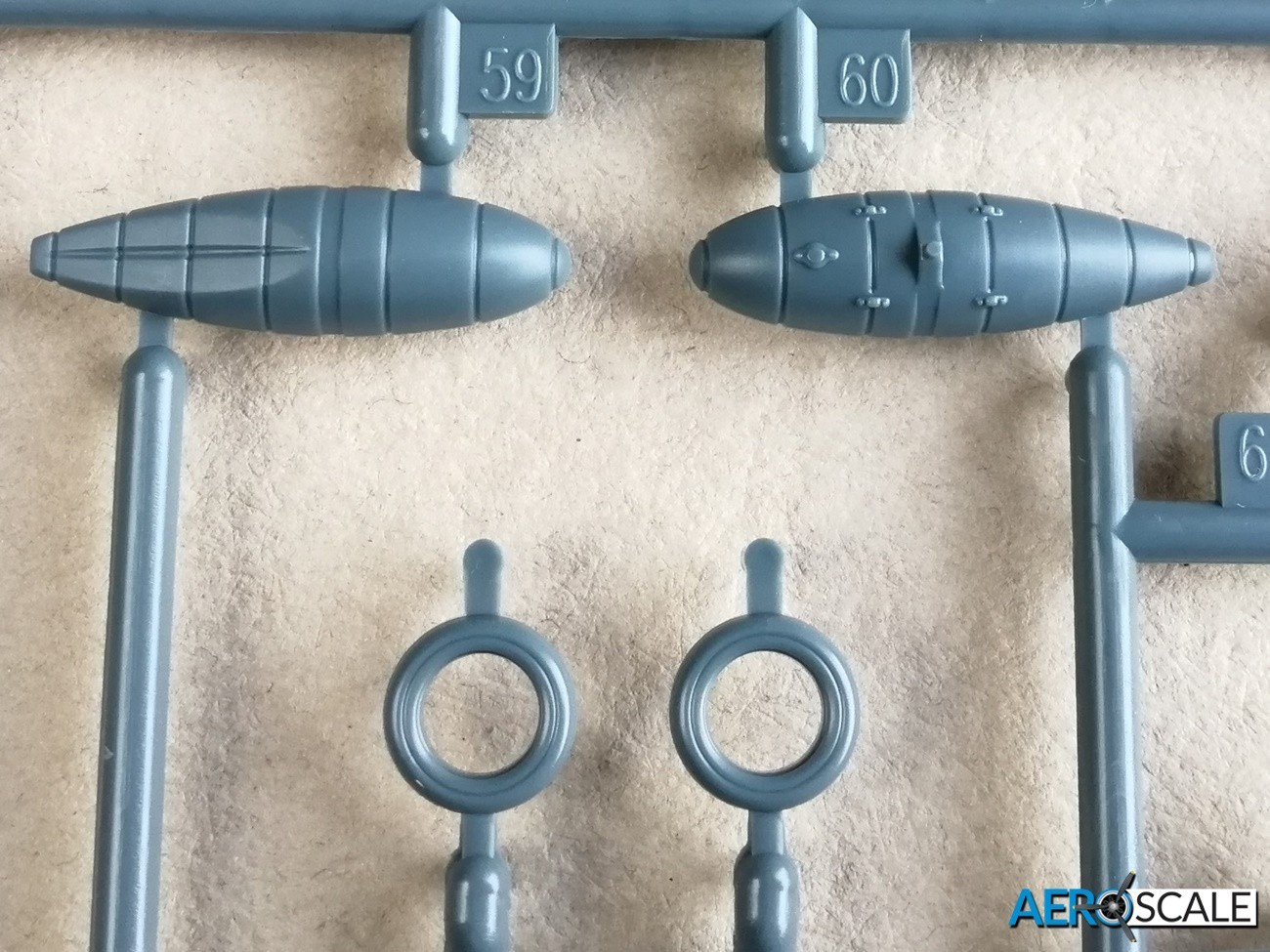

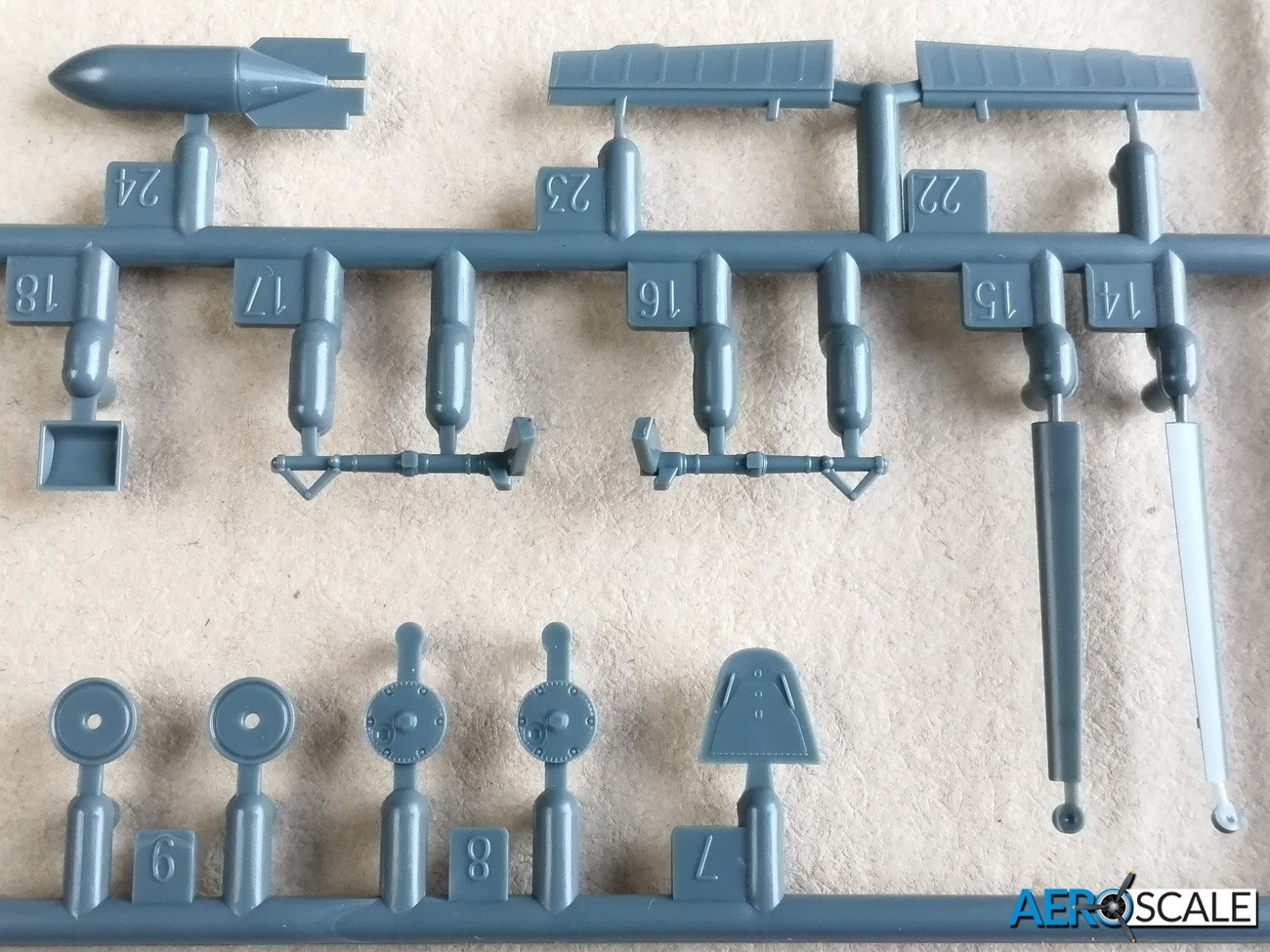
External stores include a 500kg bomb and two types of 300 litre fuel tank, both fitted under the belly. The instructions only mention fitting the SC 250 bomb and ETC bomb rack to options ’E & G’. There is a choice between plastic and PE stabilising fins and brace for the bomb’
The pre-painted PE fret contains items generally for the cockpit. The bare PE contains parts for the airframe, canopy, radiator faces, undercarriage hydraulic lines, fuselage stiffener plates, exhaust flame guards, air compressor filter, etc.
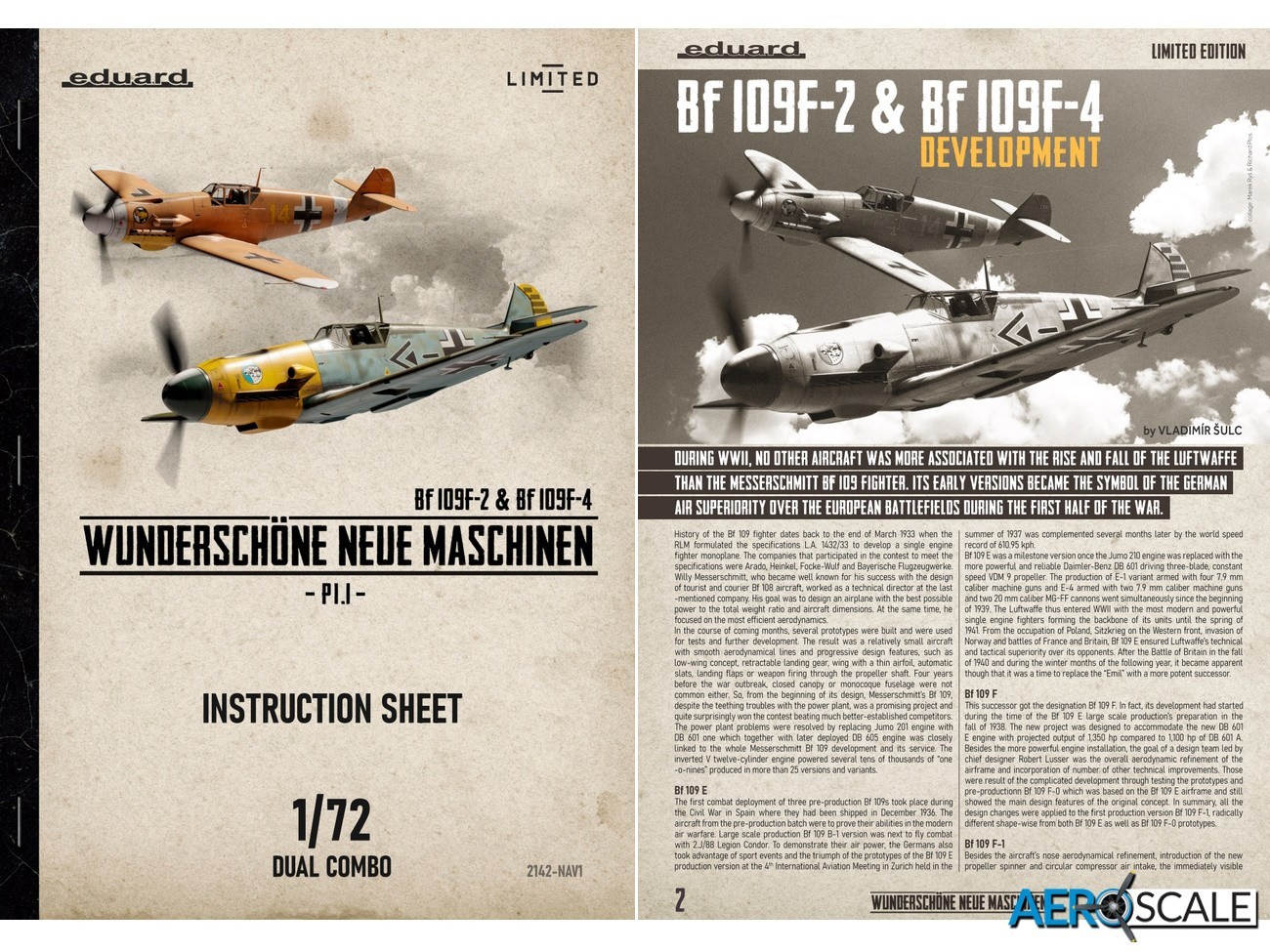
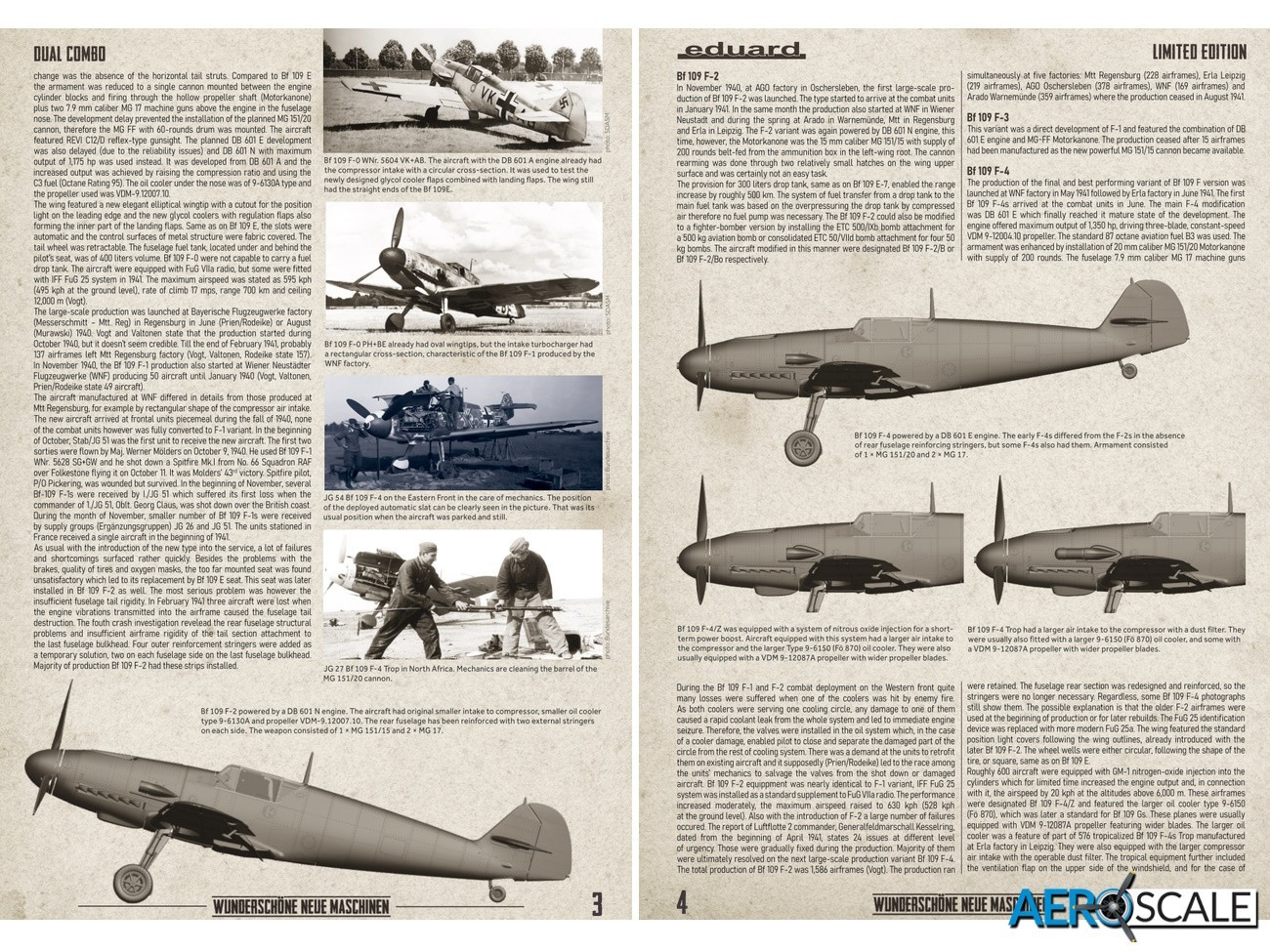
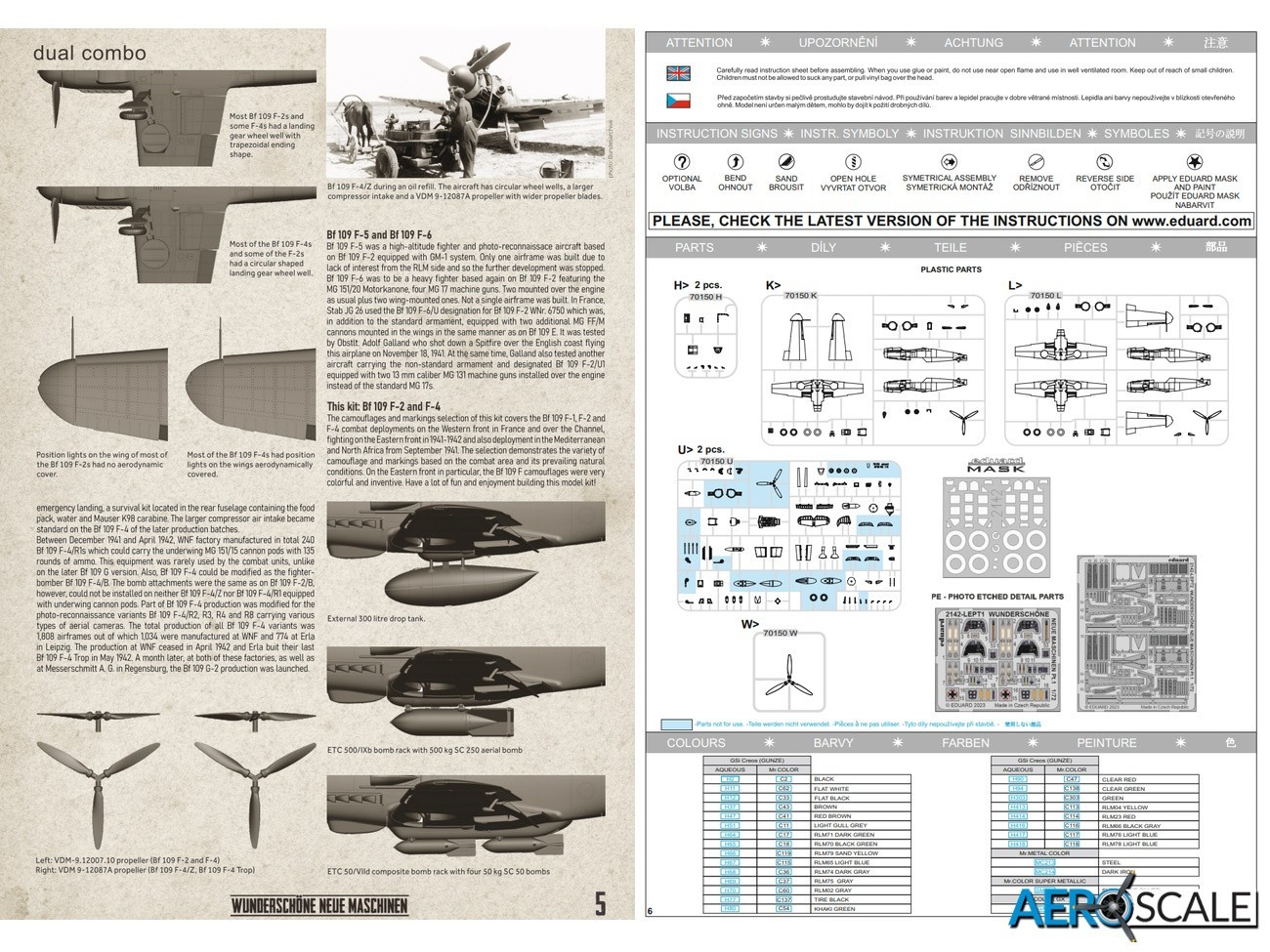
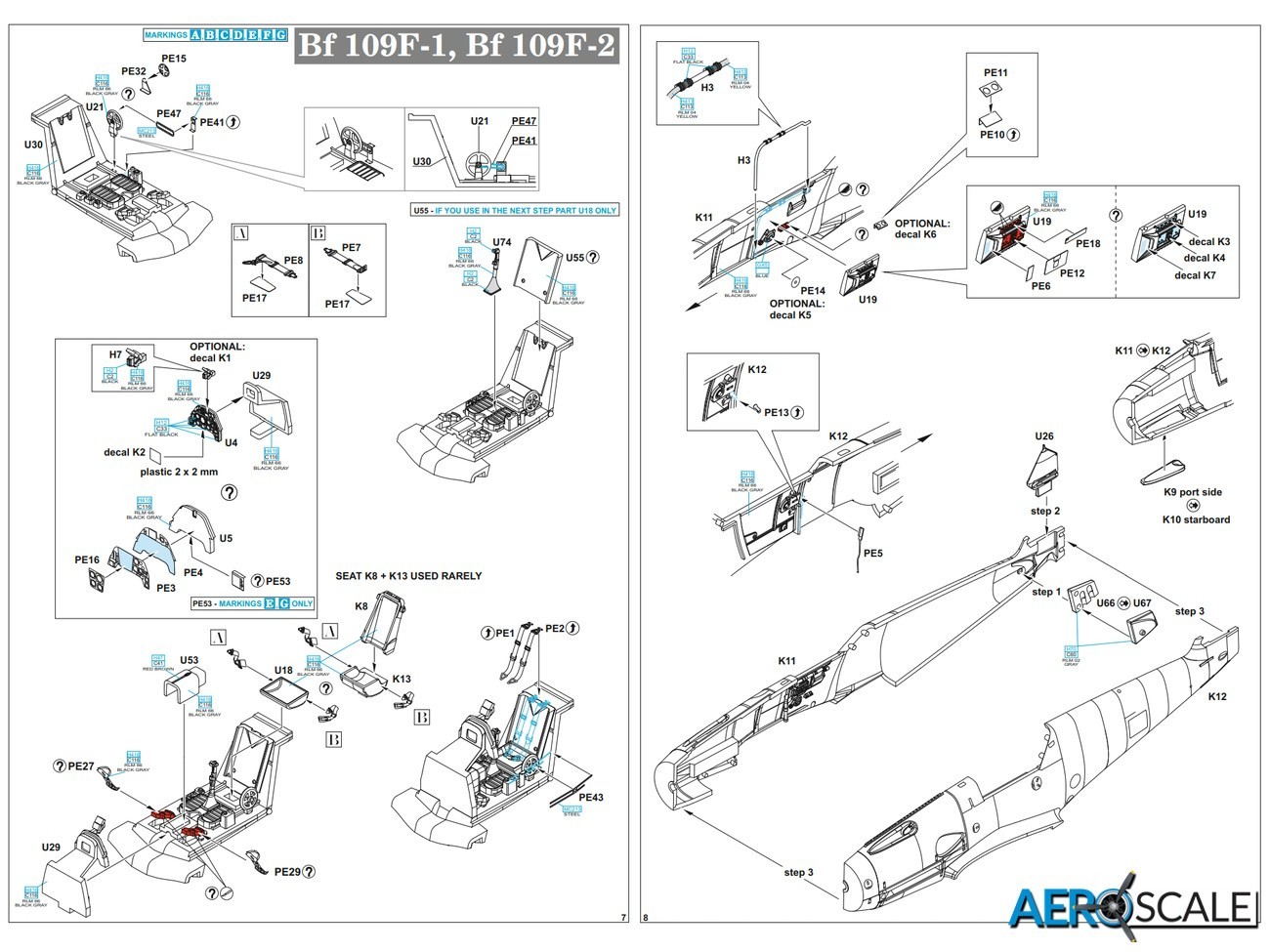
Decals look very good with good definition and colour strength. The larger of the three sheets have have insignia and markings. The swastikas are printed in two parts. The two smaller sheets contain the stencils and there are quite a few to apply. Hatched red and black wing walkways are included
Paint masks are included for the greenhouse style canopy and windscreen, the main and tail wheels as well as the navigation lights on the wing tips.
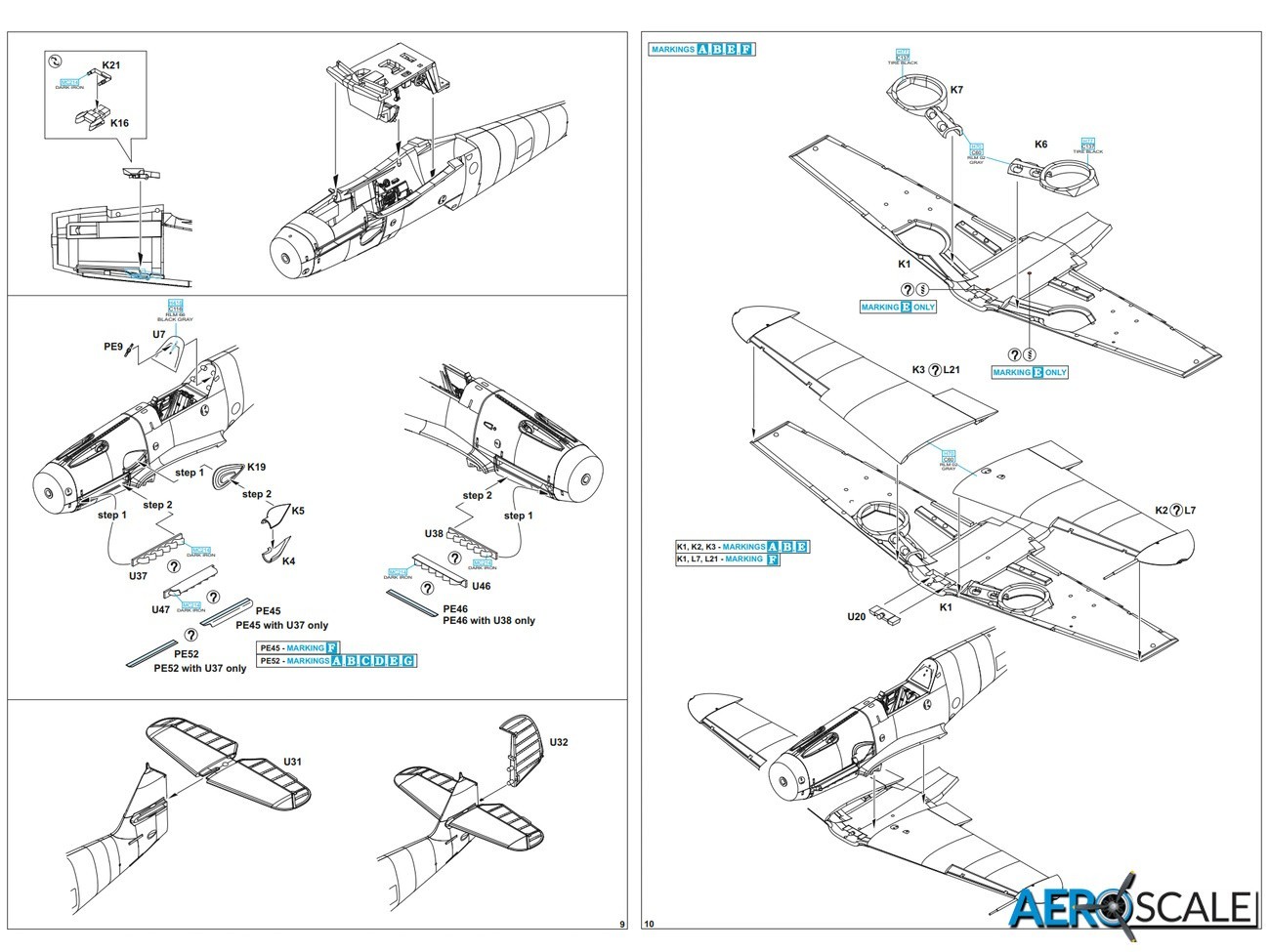

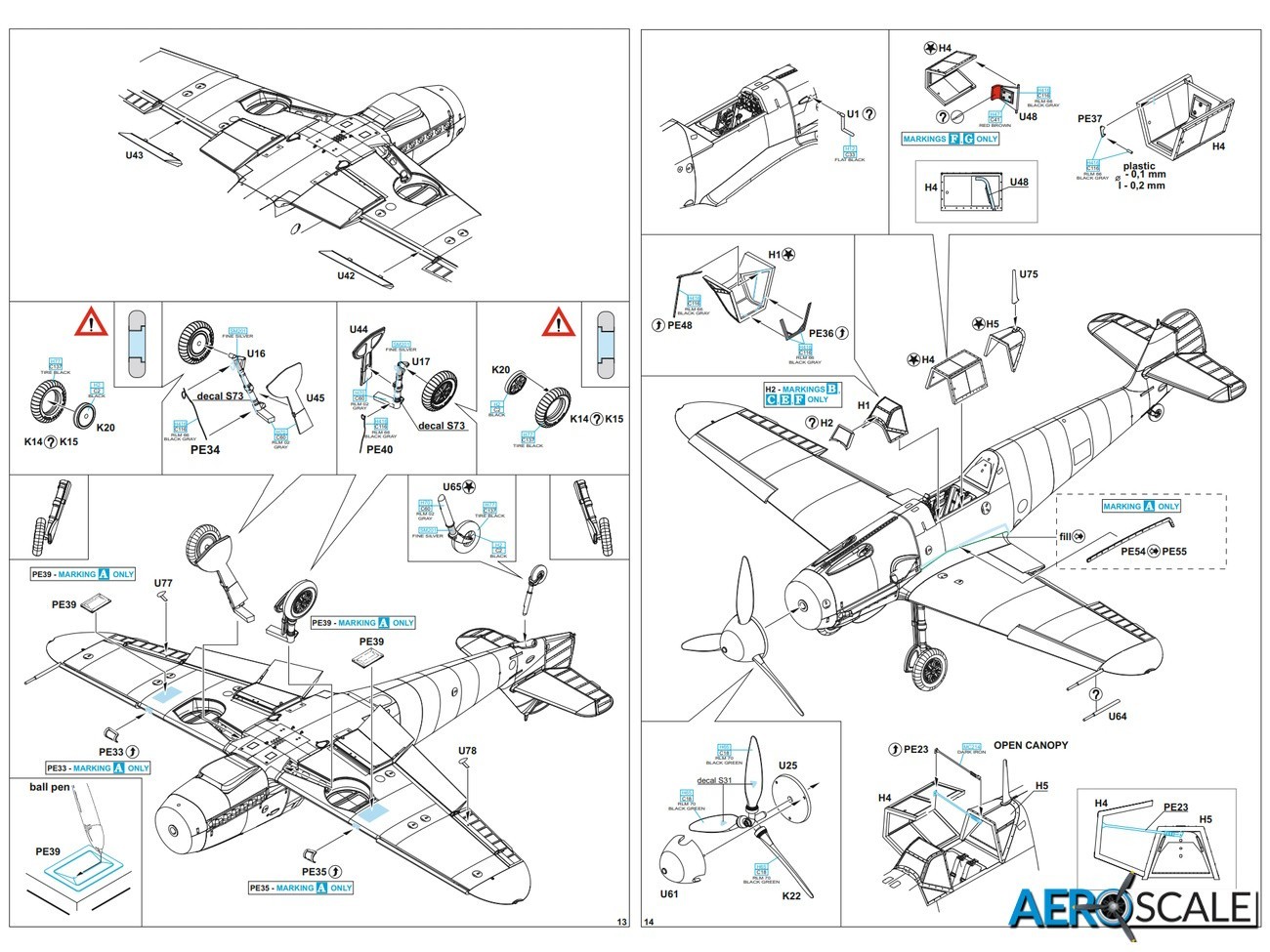
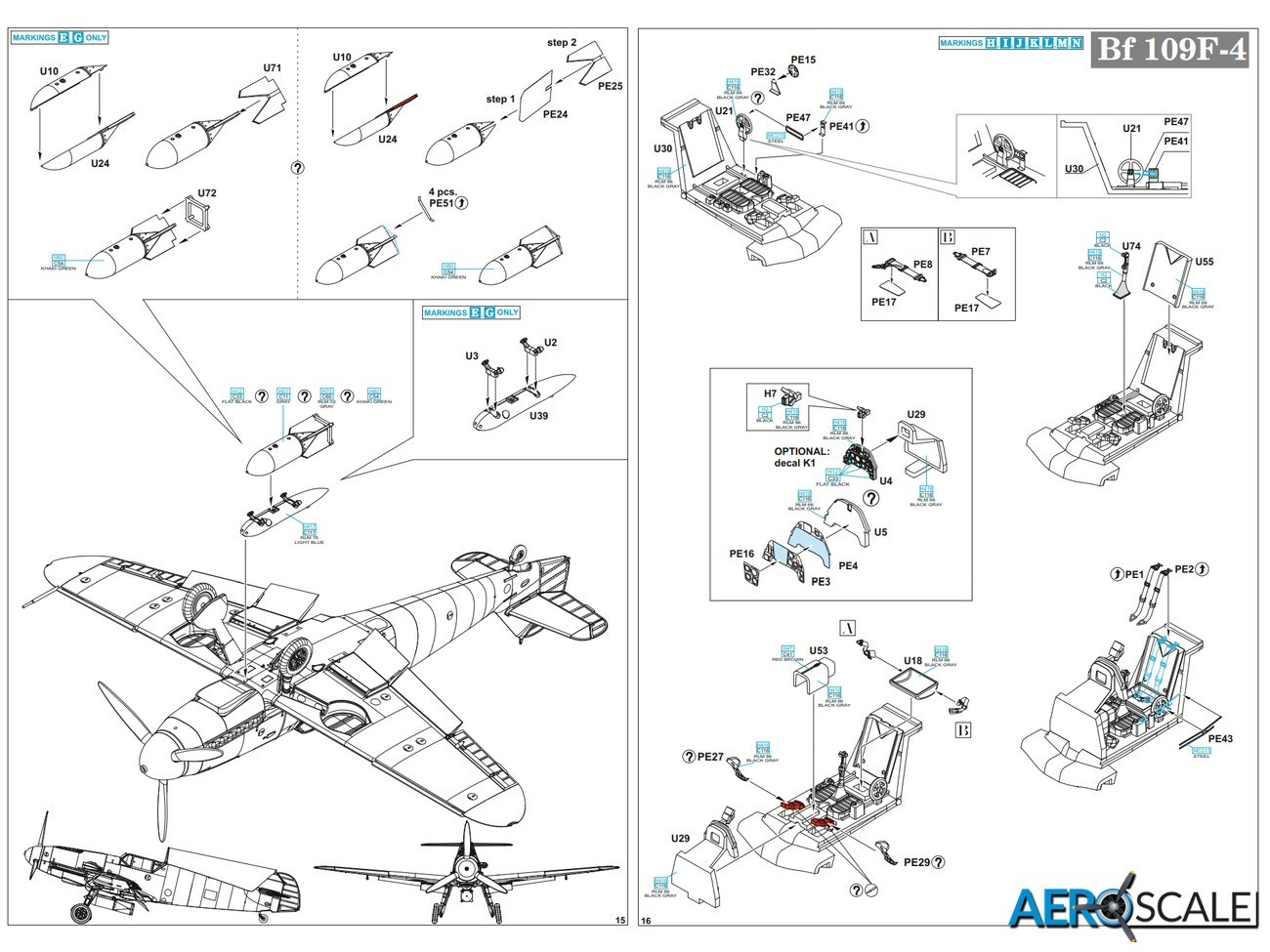
The A-4 format instruction contains a bumper forty pages. The first four inner pages feature illuminating illustrated information on the F-0/2/4/5 &6. Construction guidance treats the build of the F-1/2 and F-4 separately. Build is not entirely straight forward and took a couple of reads for things to be clear. The size of the drawings makes construction and placement of parts so much easier. Full colour painting guide is included with four view drawings of each marking option. There is a separate page solely for applying the stencils Gunze: Aqueous, Mr Color, Mr Metal Color and Mr Color Super Metallic paint numbers are used for colour reference.
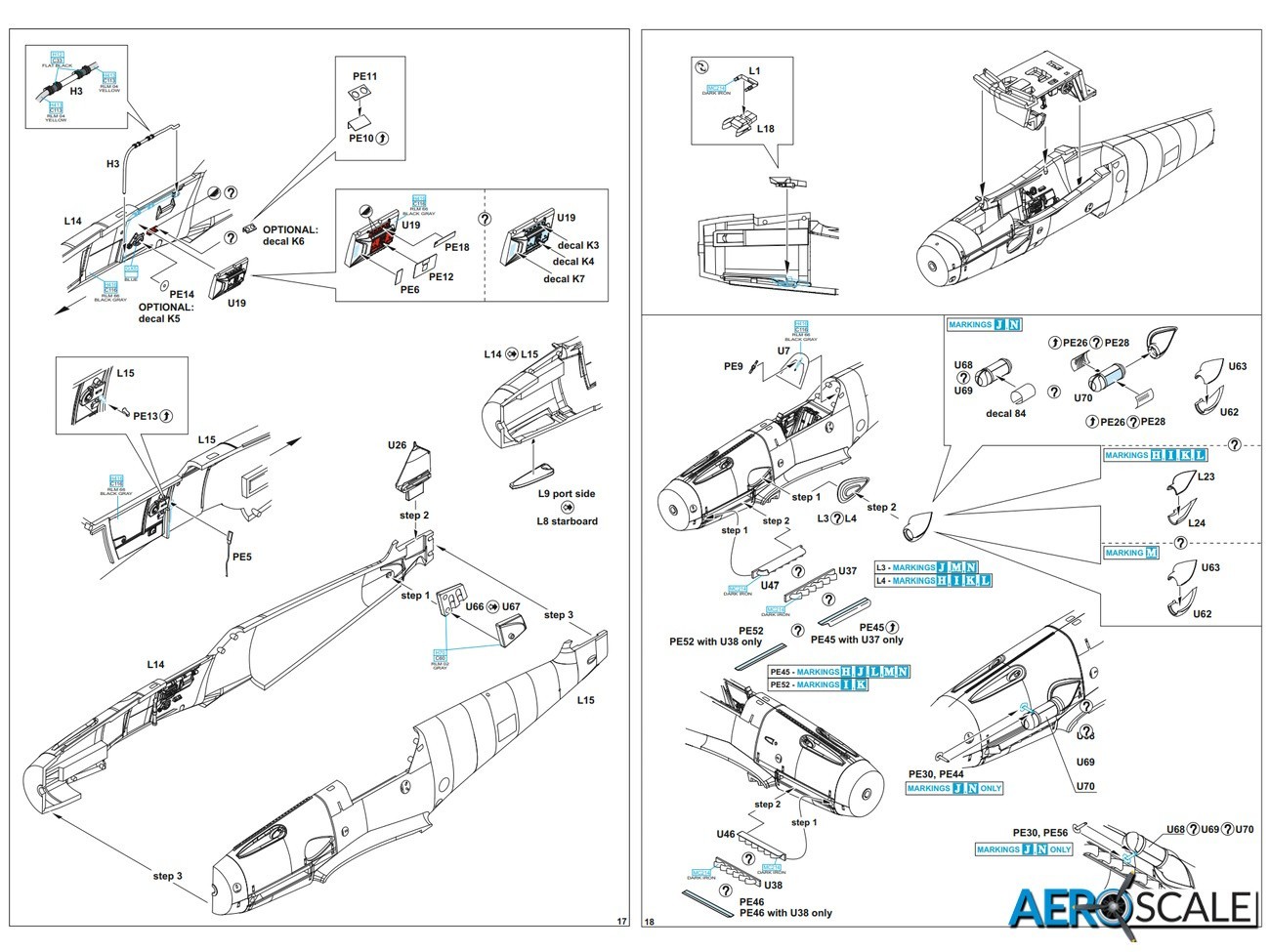

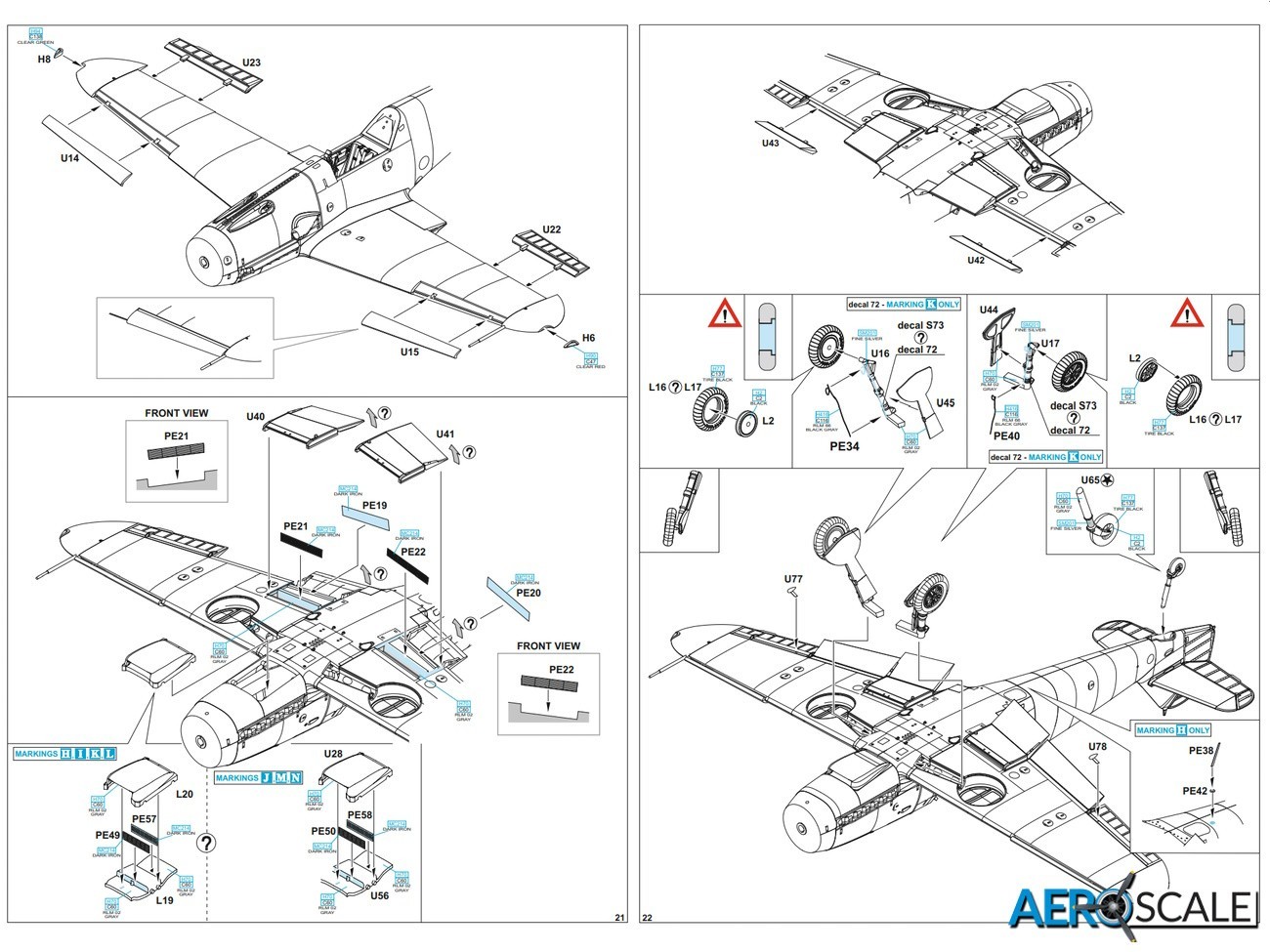
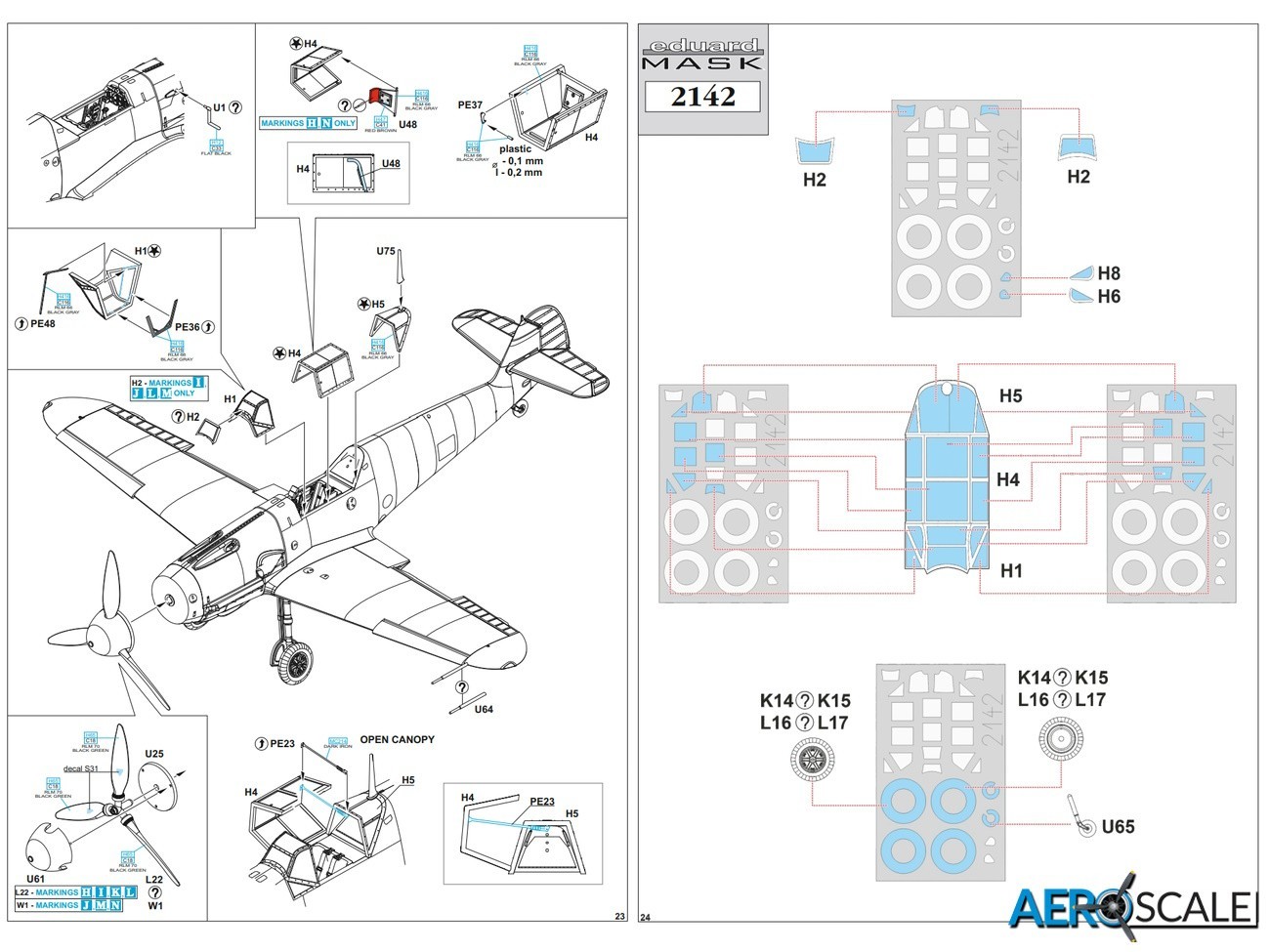
Although the Fredrick might have been short lived, the marking options include a wide variety of camouflage reflecting the widespread use of the Bf 109 F
- 1 x Bf 109 F-1
- 6 x Bf 109 F-2
- 7 x Bf 109 F-4 [including 2 x trop]
NOTE: that the kit does NOT include the Knight's Cross, which is shown on the box top illustration
Many thanks to Eduard for sending this sample for review on Aeroscale.
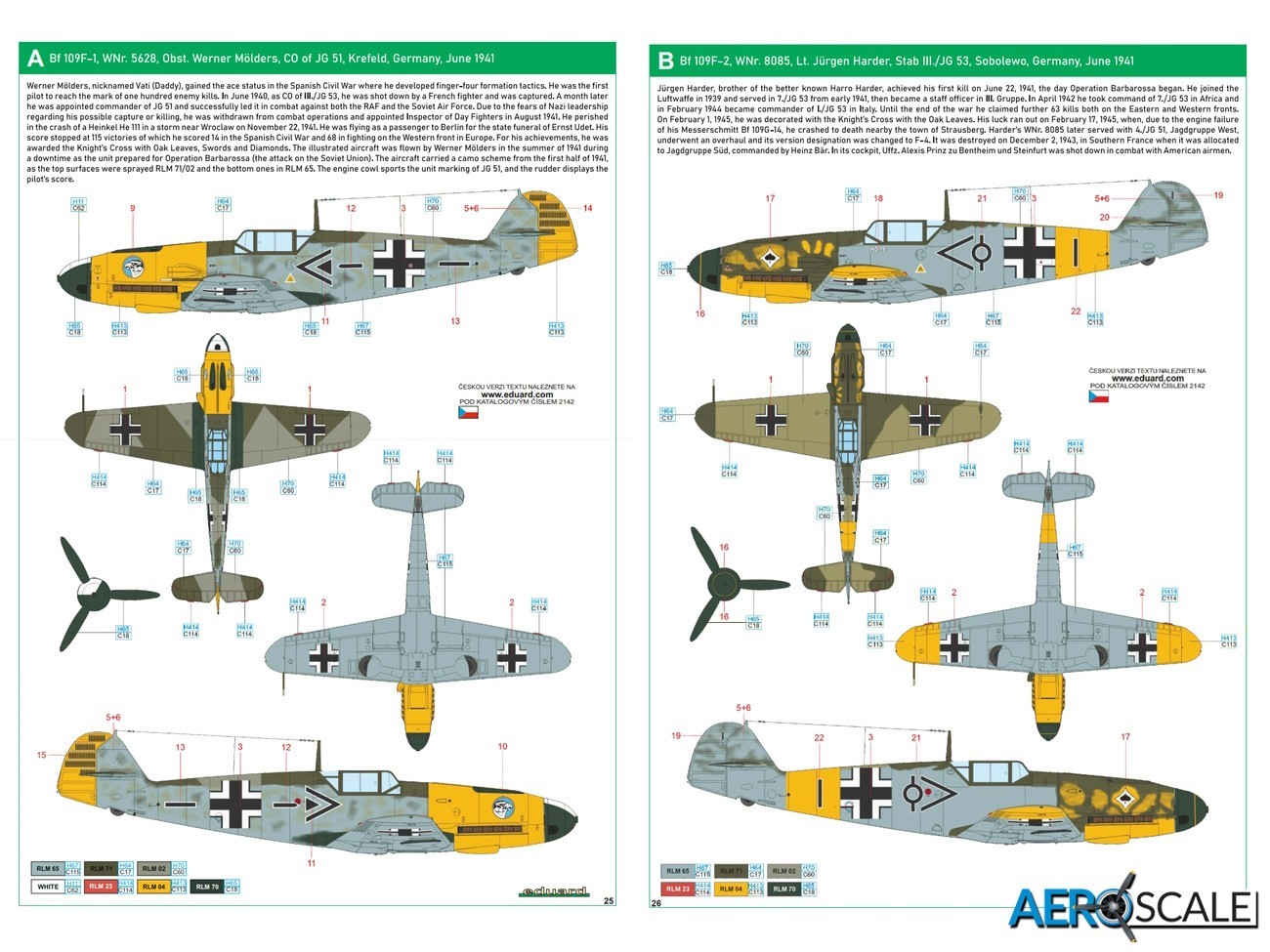
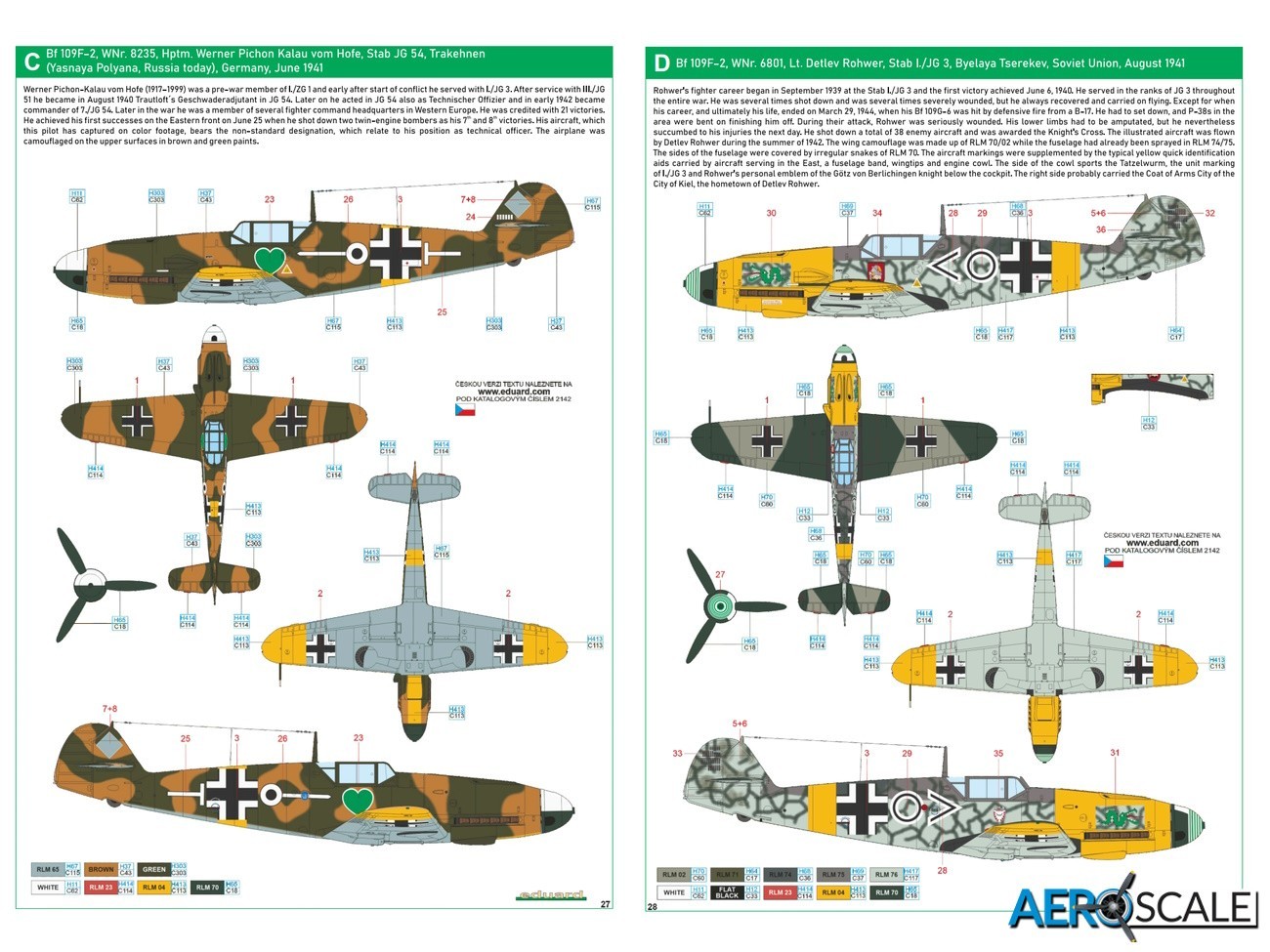
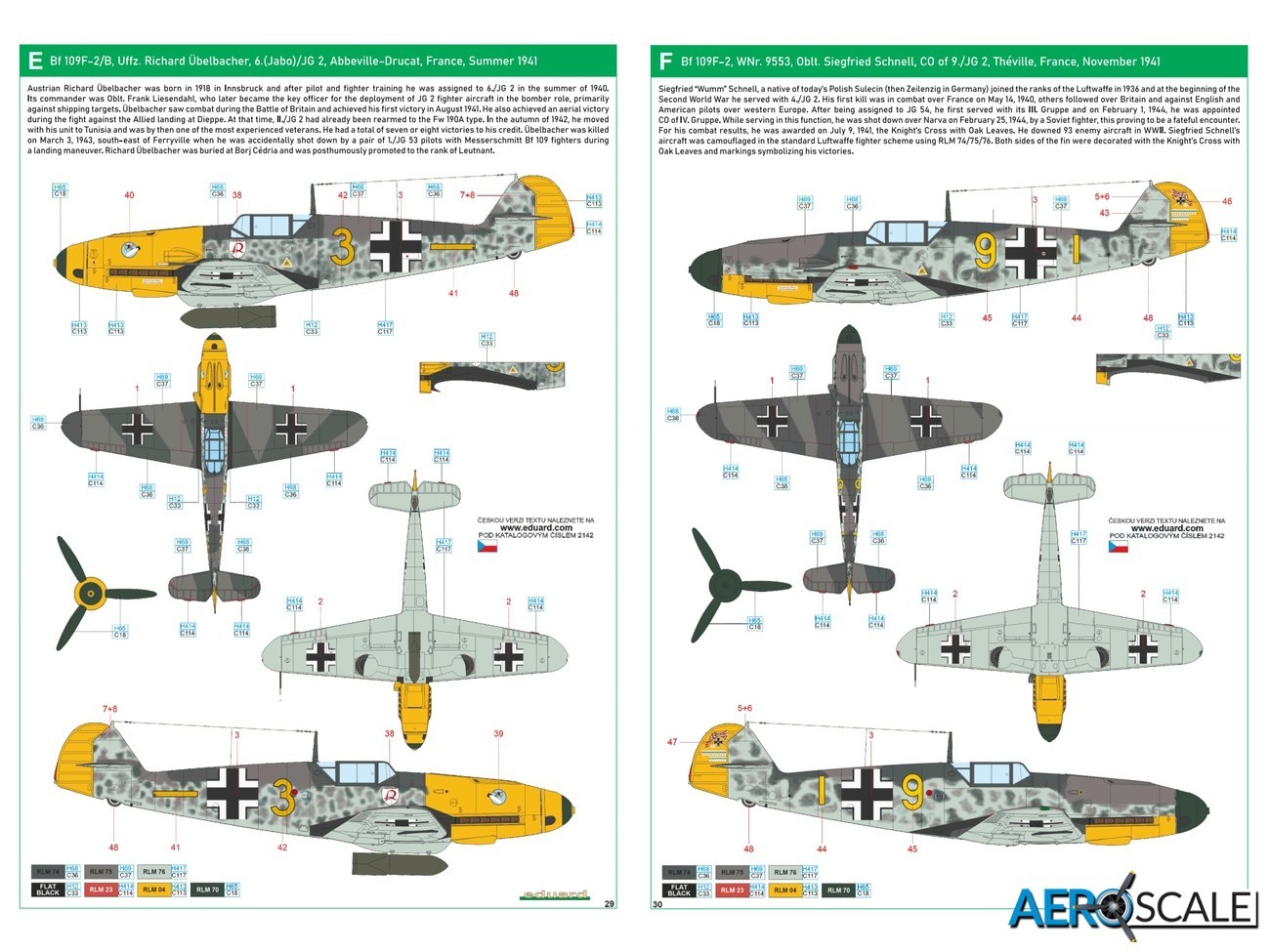
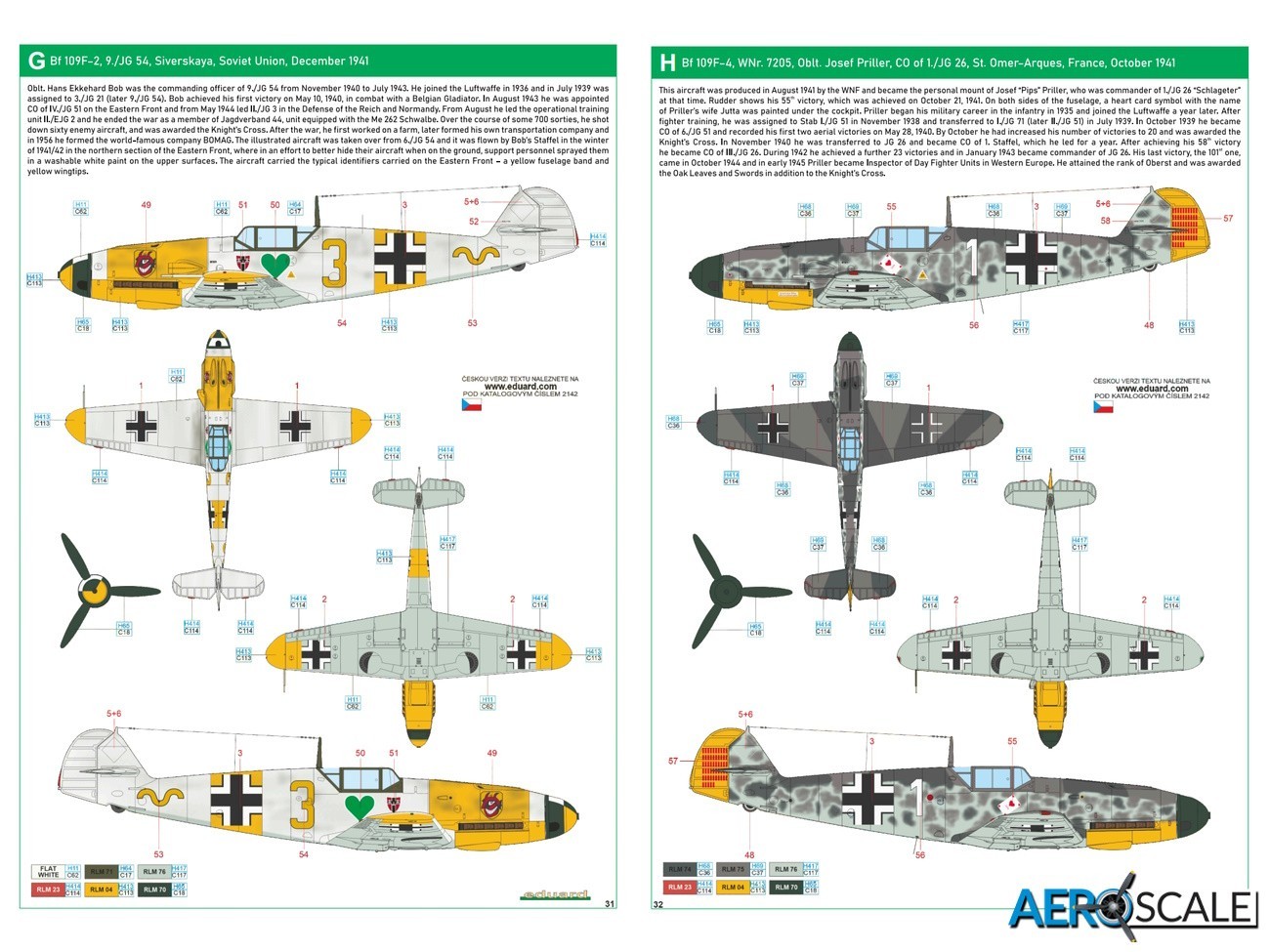
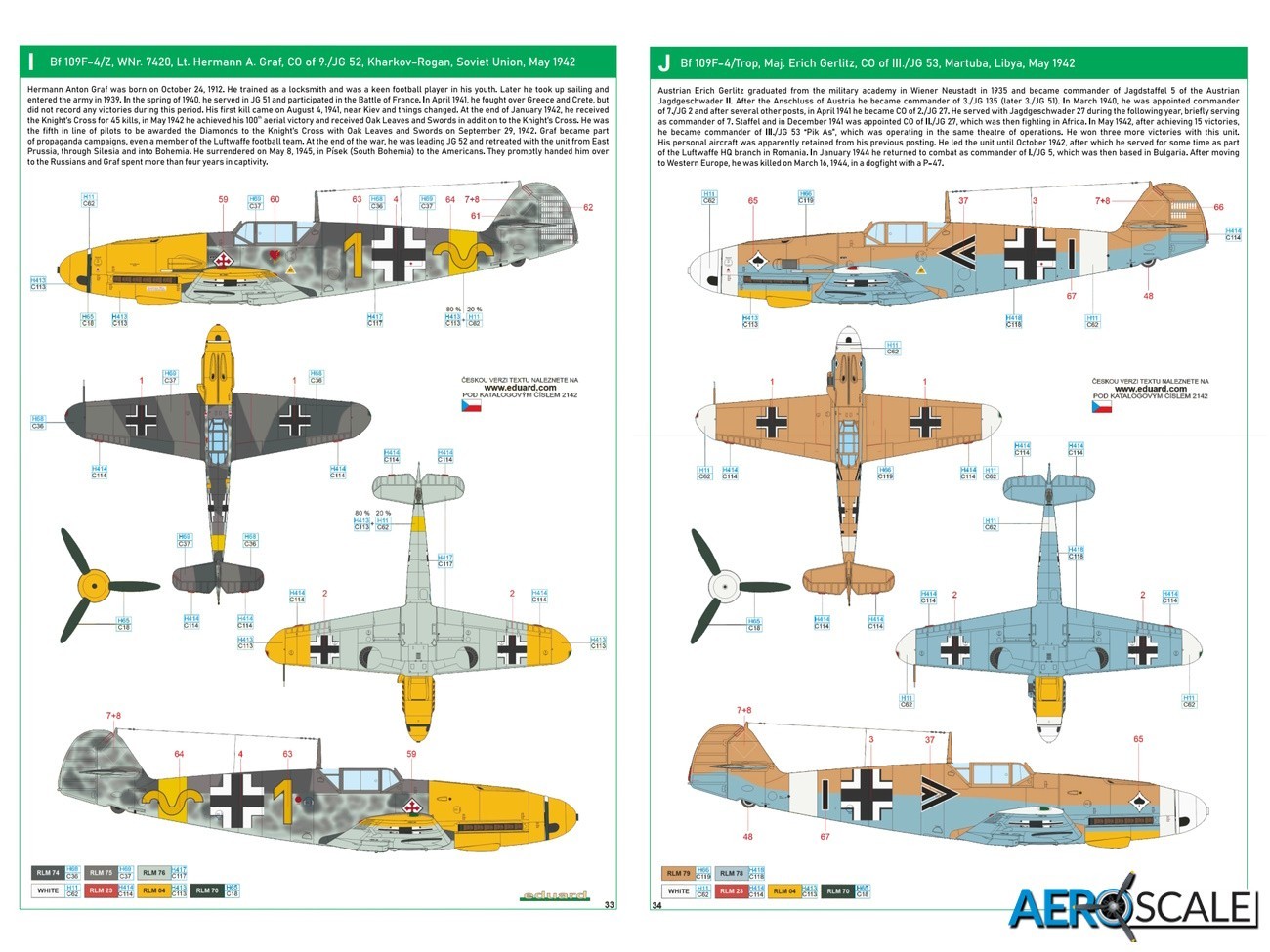
Conclusions
Well Eduard has not let the modelling community down with this beauty. The plastic detail for this scale is superb. The inclusion of the PE detail raises the level of detail a few notches. The kit leaves no detail left upturned and so the instructions will require some study to get the most out of it. Not a release for the novice as their some work involving small and delicate PE parts particularly around the cockpit and canopy.
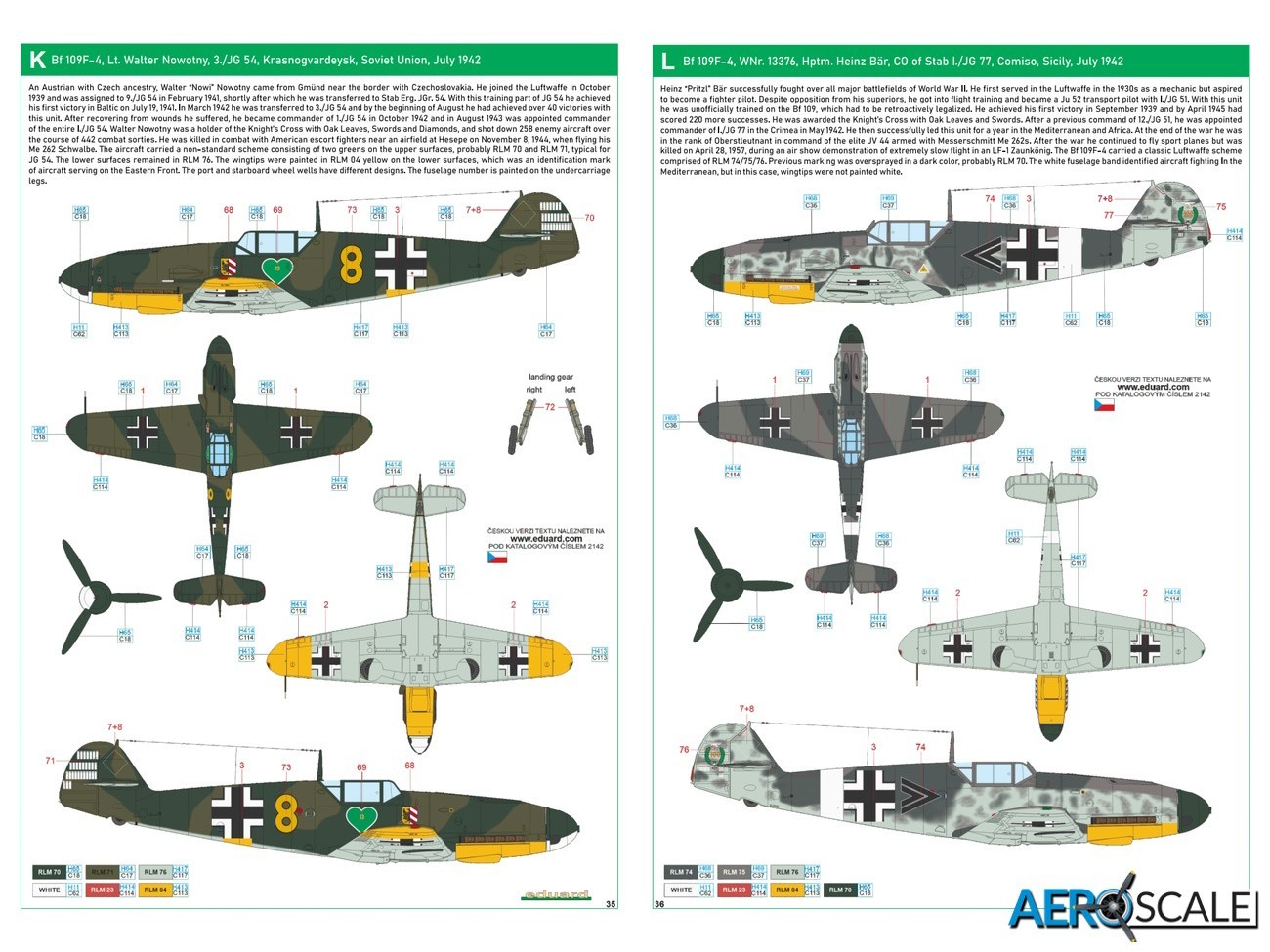

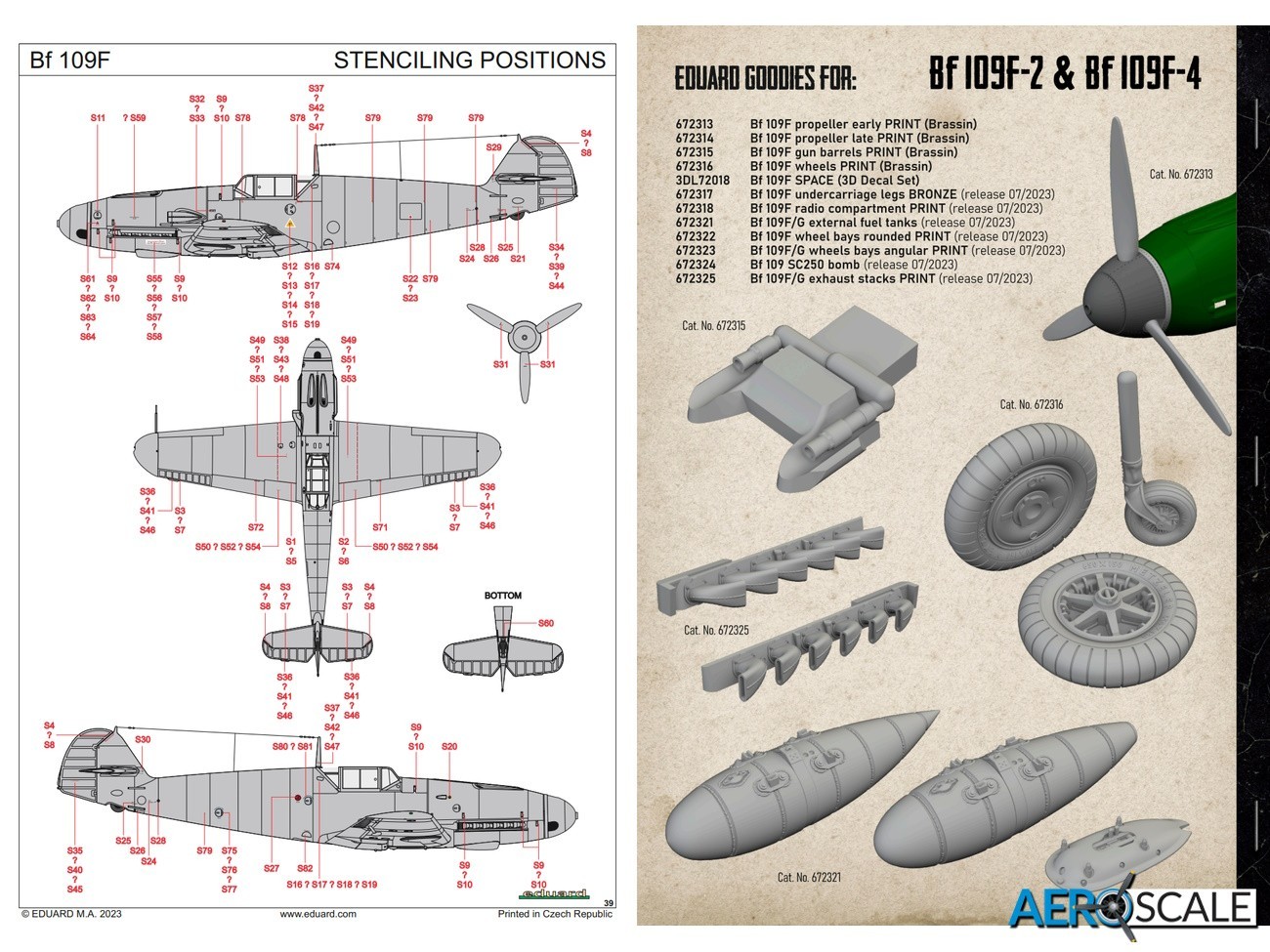
Magnus Fridsell is coming to the end of the build of this release, check out his blog on the Kitmaker Network
Price from the Eduard online store of this Limited Edition Dual Combo is a very reasonable 615.70 Kč [£22.03]
2142 - Wunderschӧne Neue Maschinen Part 1 – 1:72
Please remember, when contacting retailers or manufacturers, to mention that you saw their products highlighted here – on AEROSCALE.











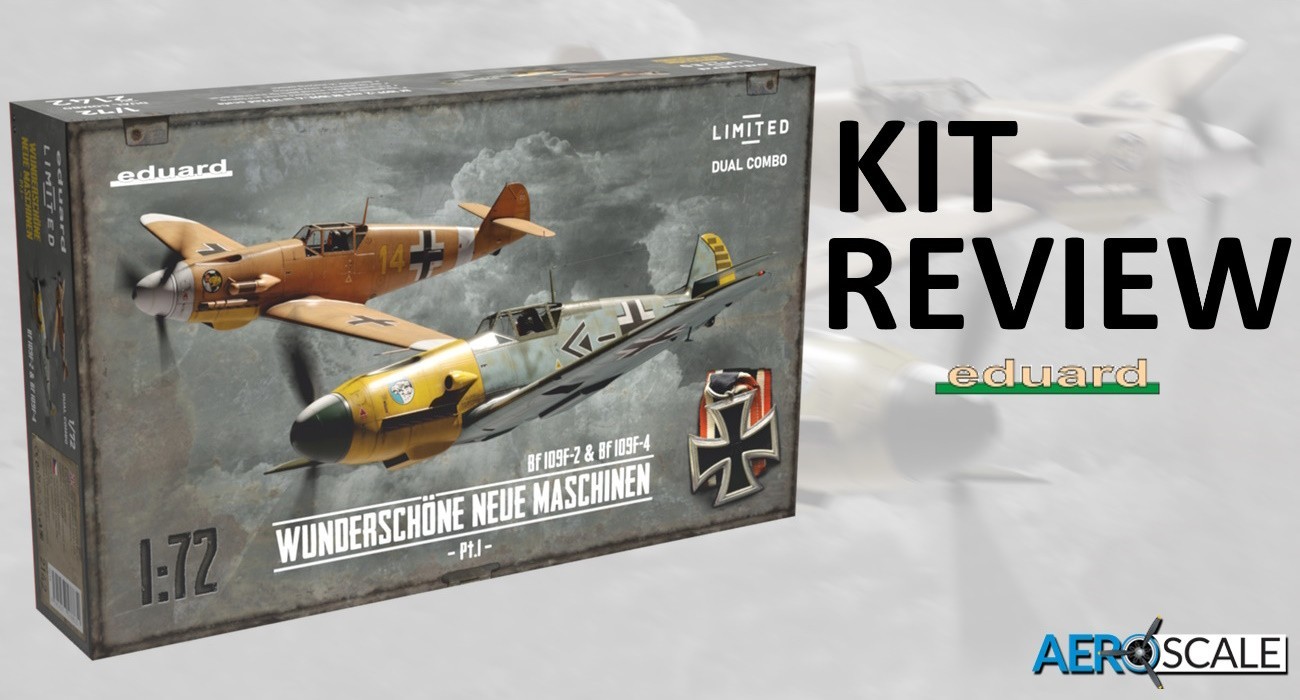






![MiG-3 [late] ‘Winter Air Defence’ Incoming](/upload/media/posts/2025-06/20/mig-3-late-winter-air-defence-incoming_1750437150-s.jpg)


